
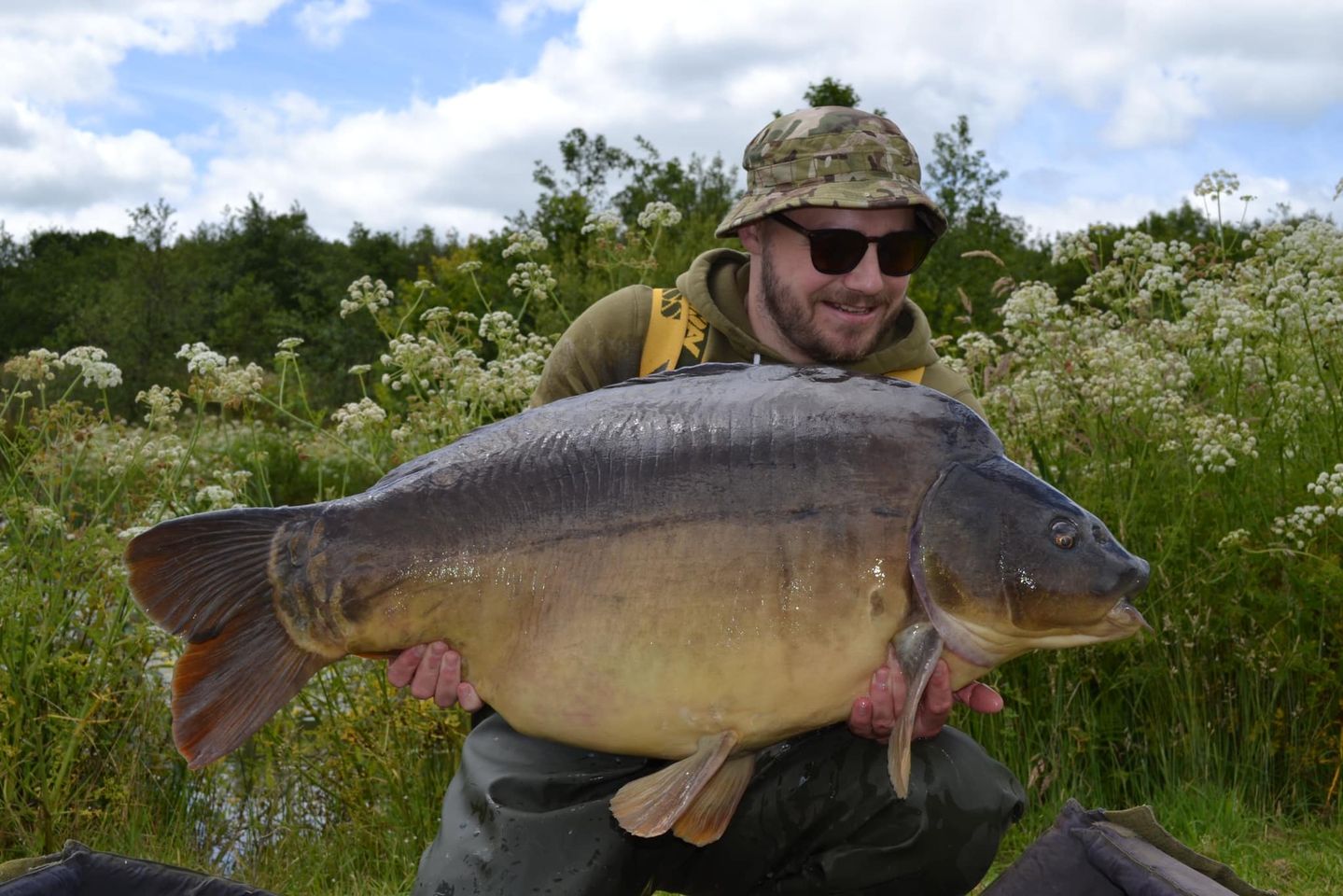
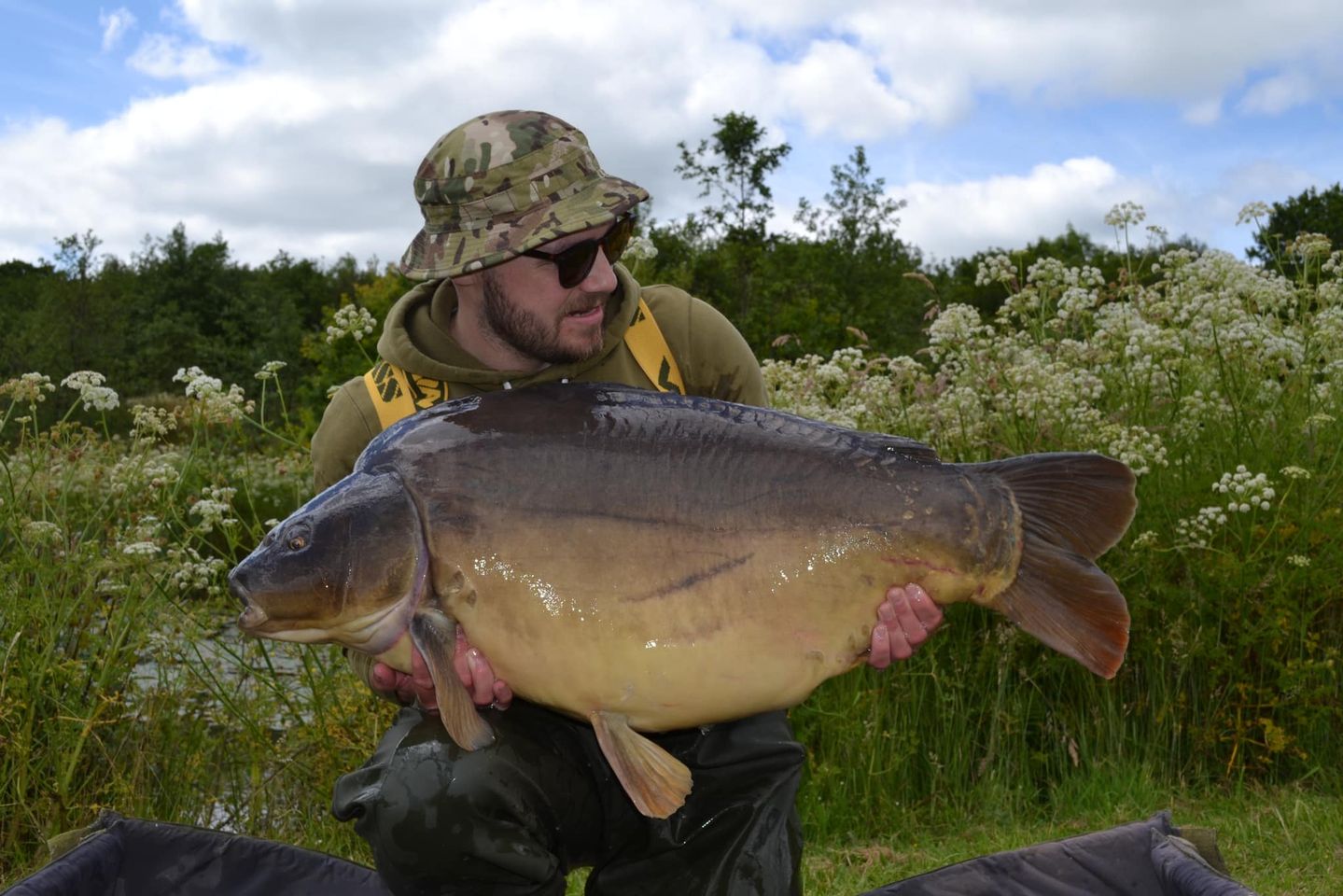


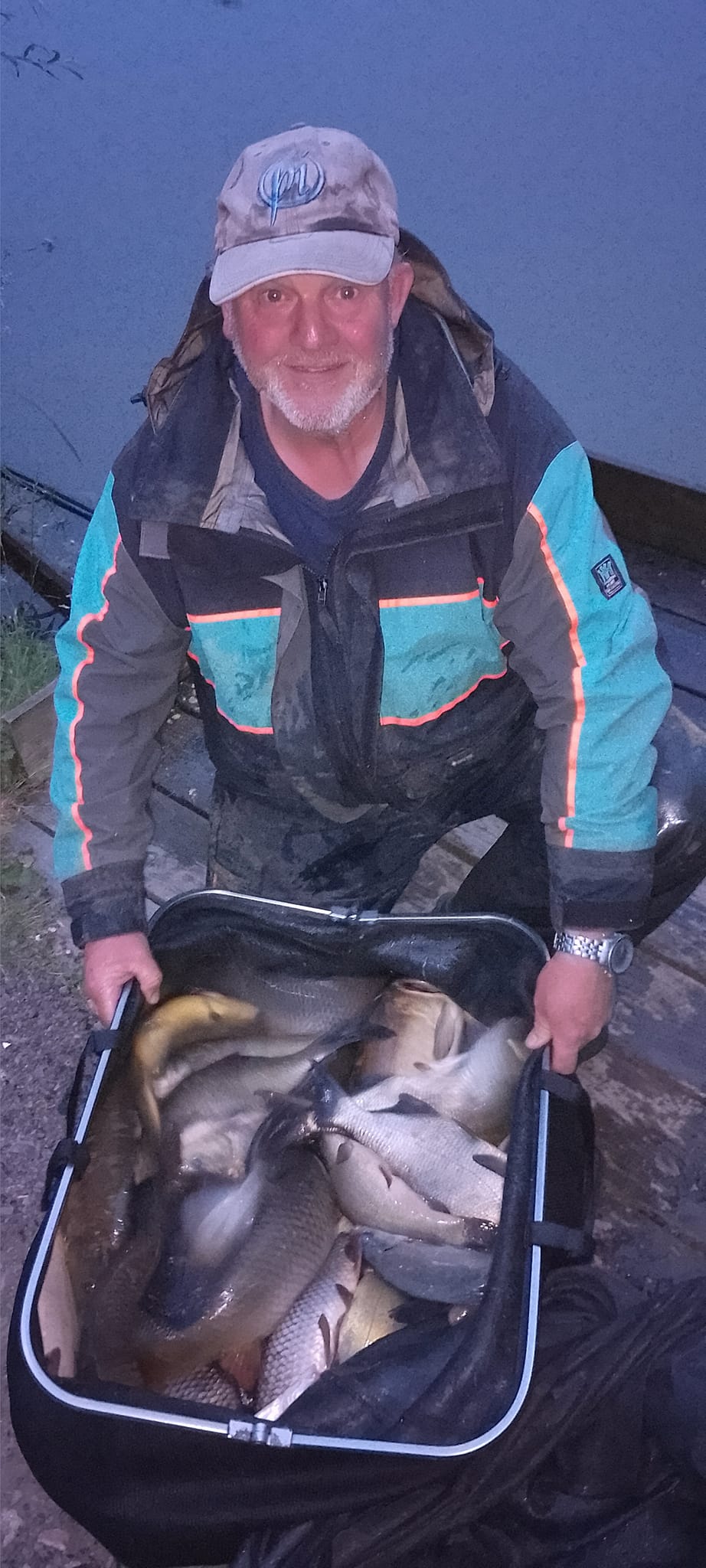
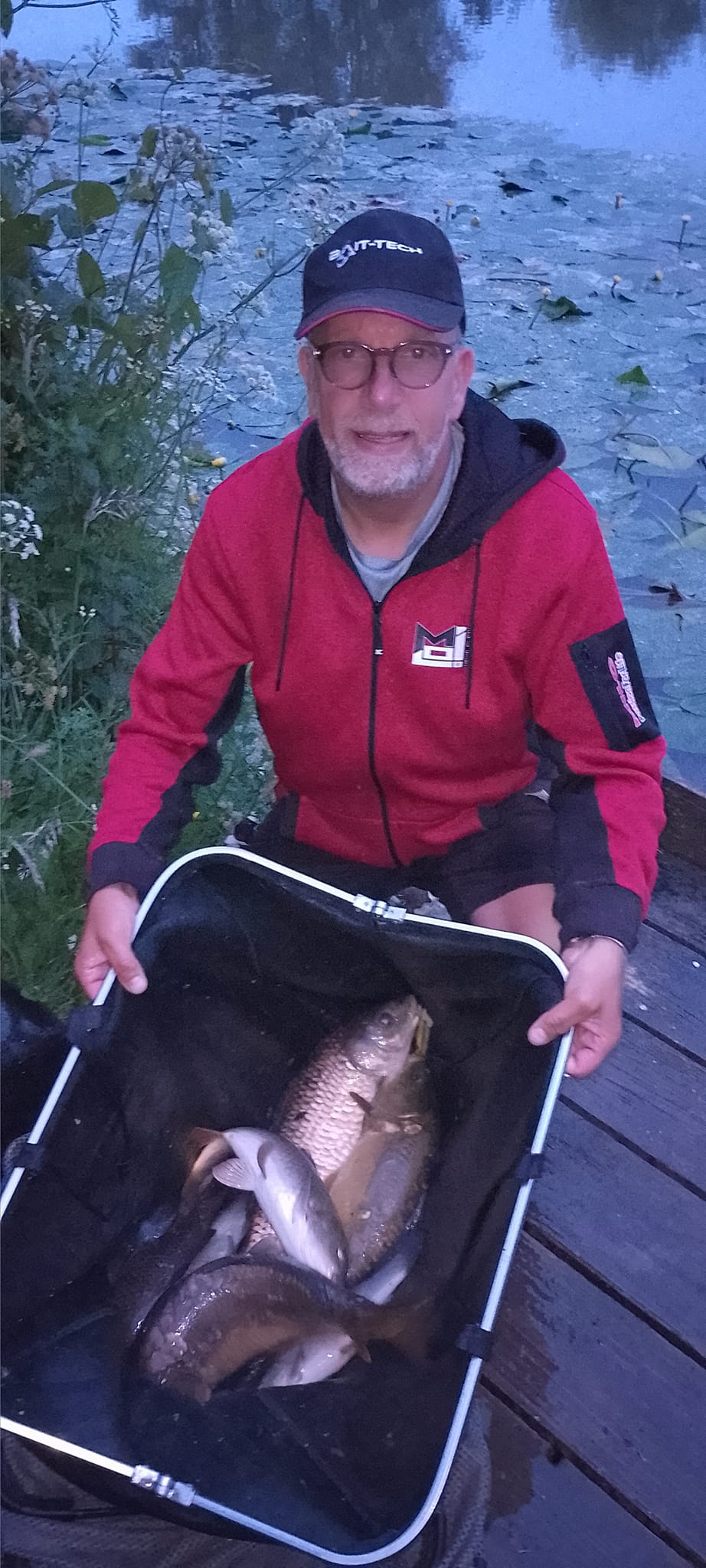
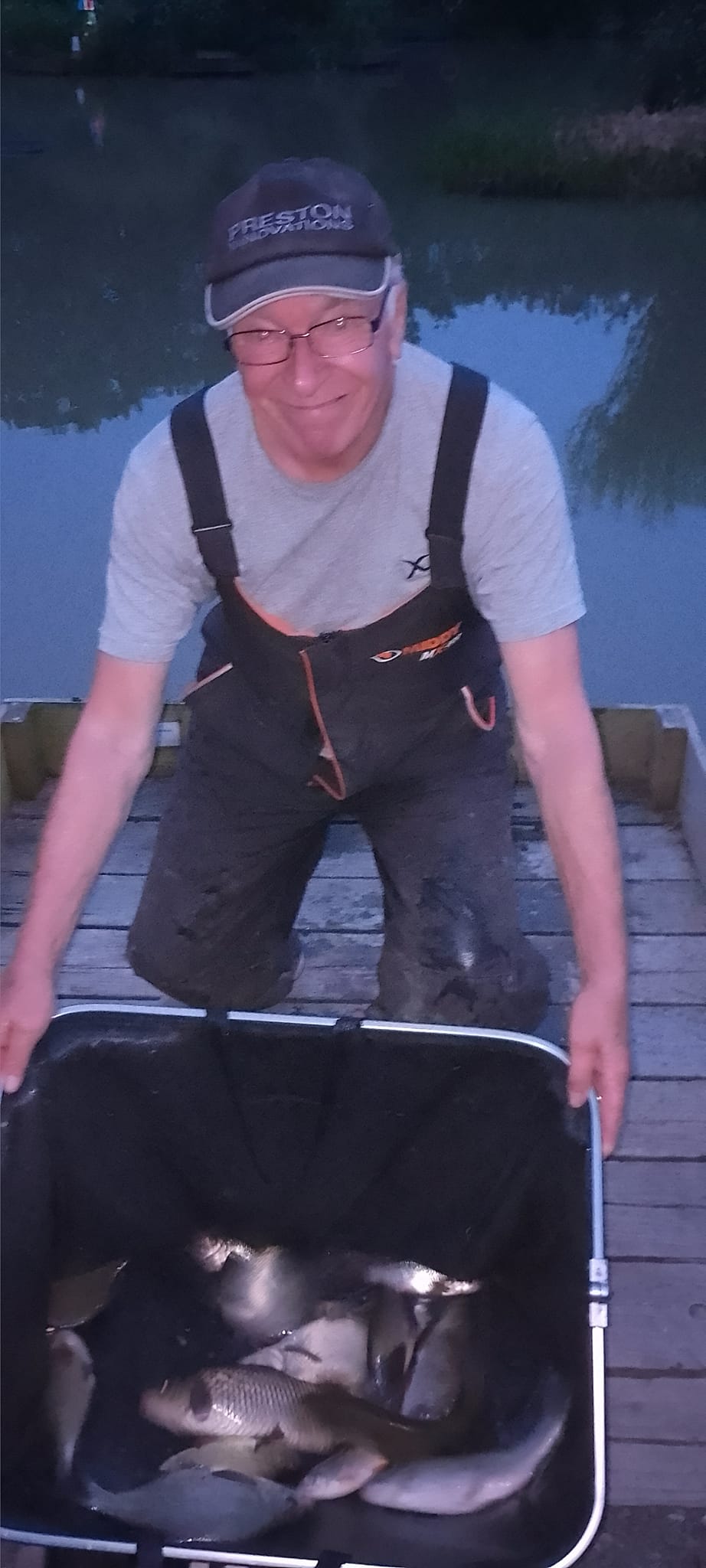

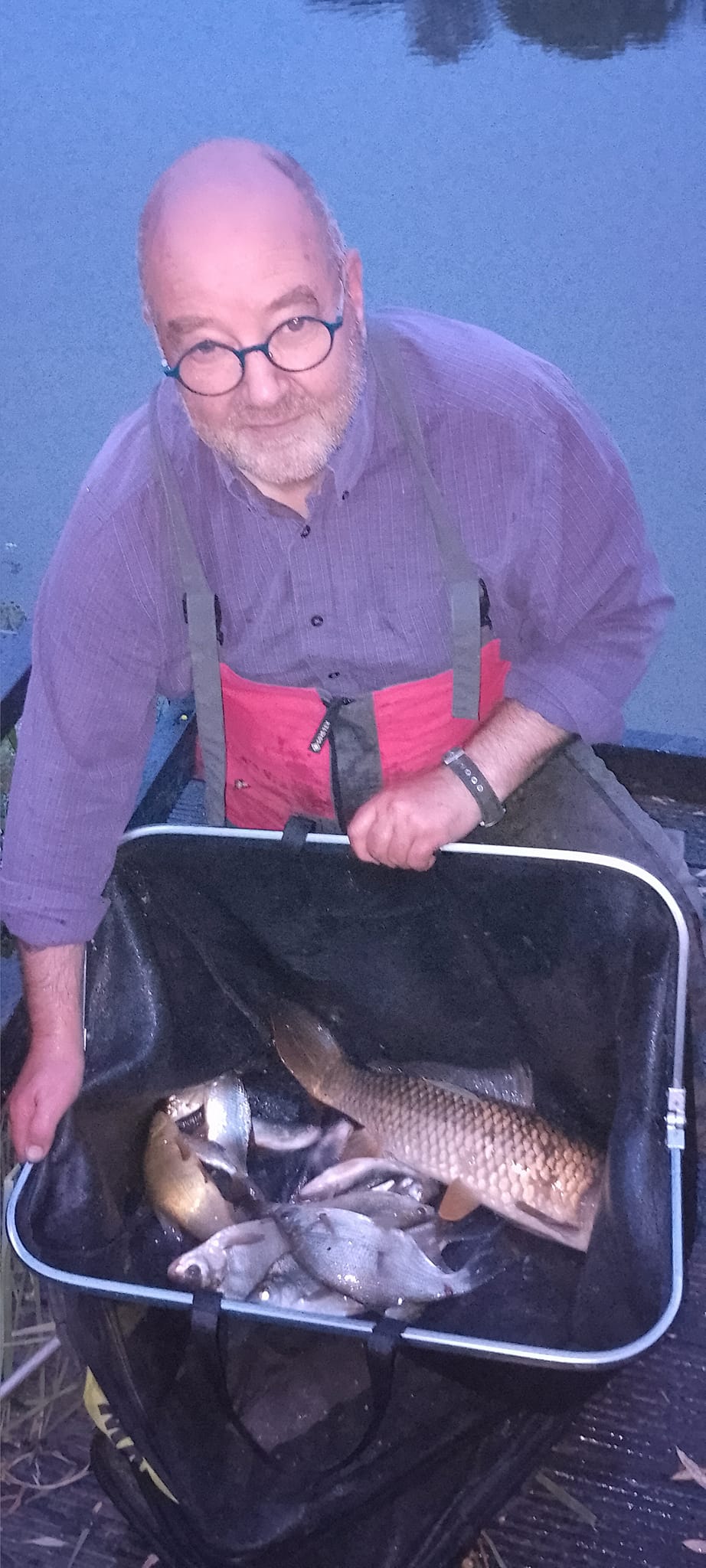
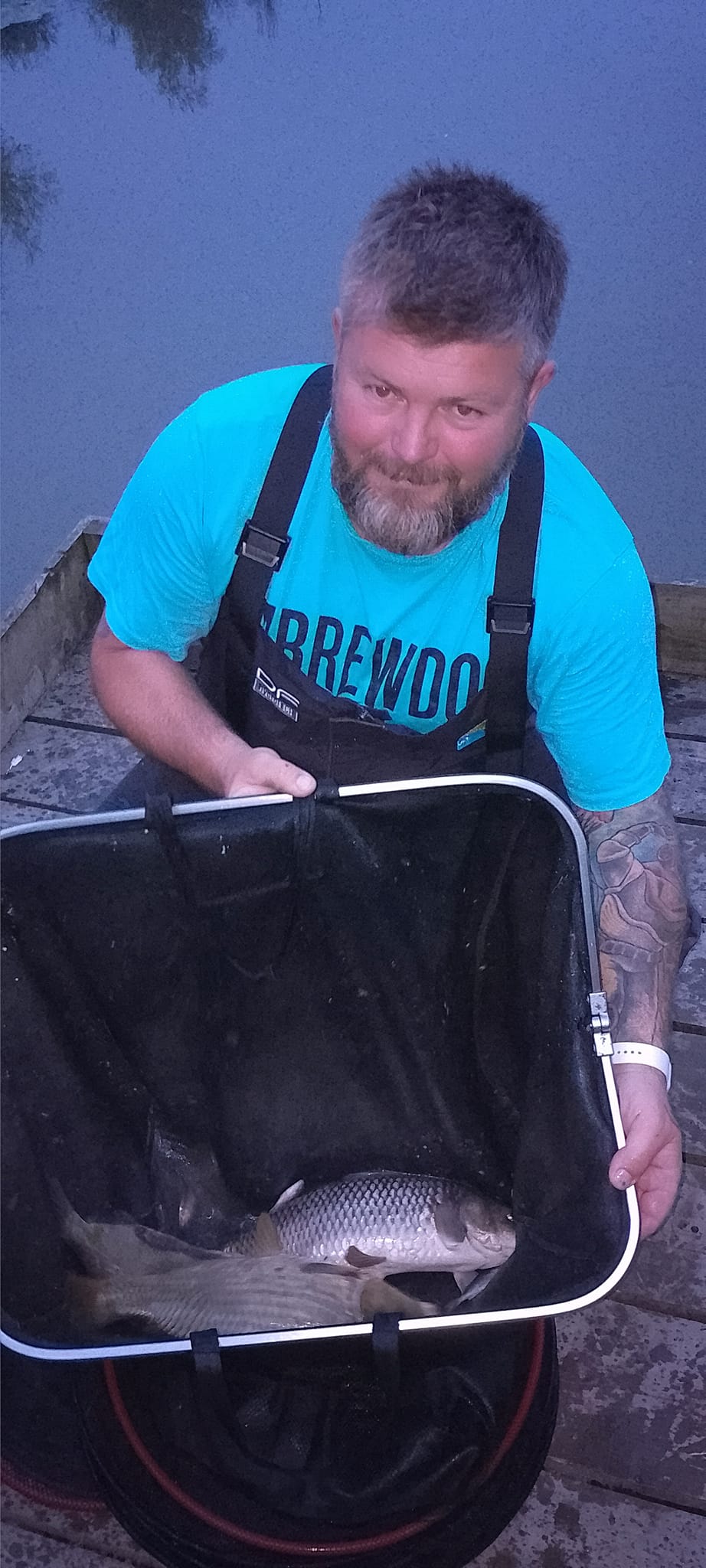
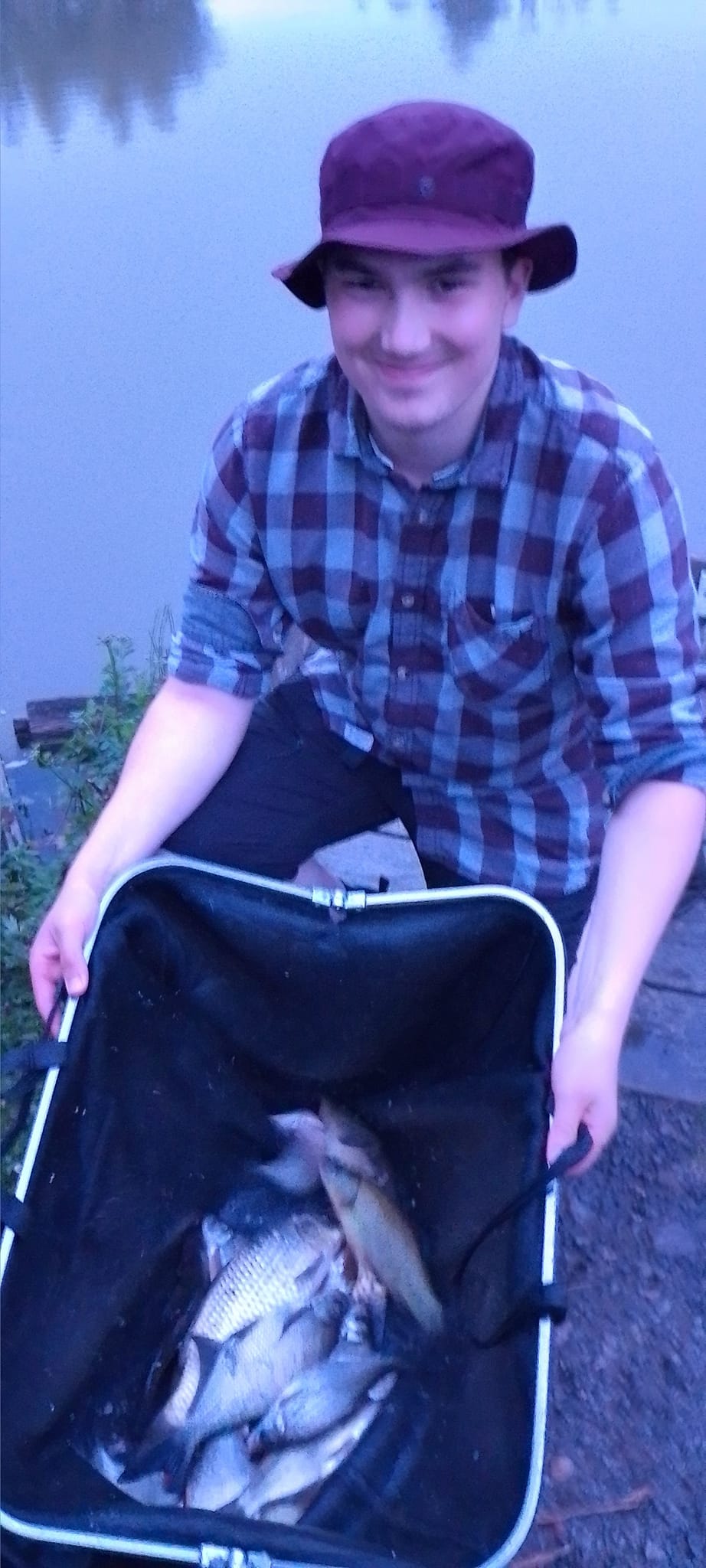
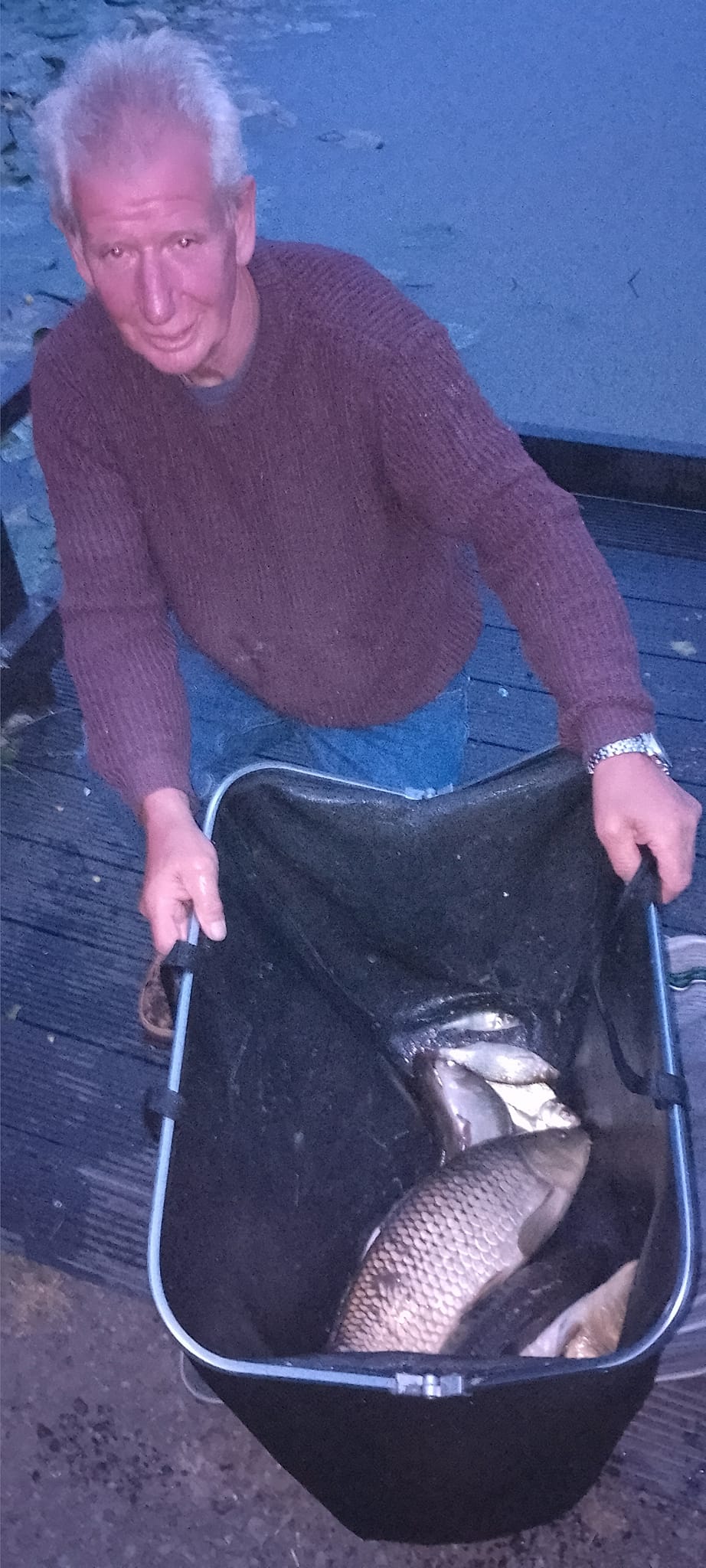
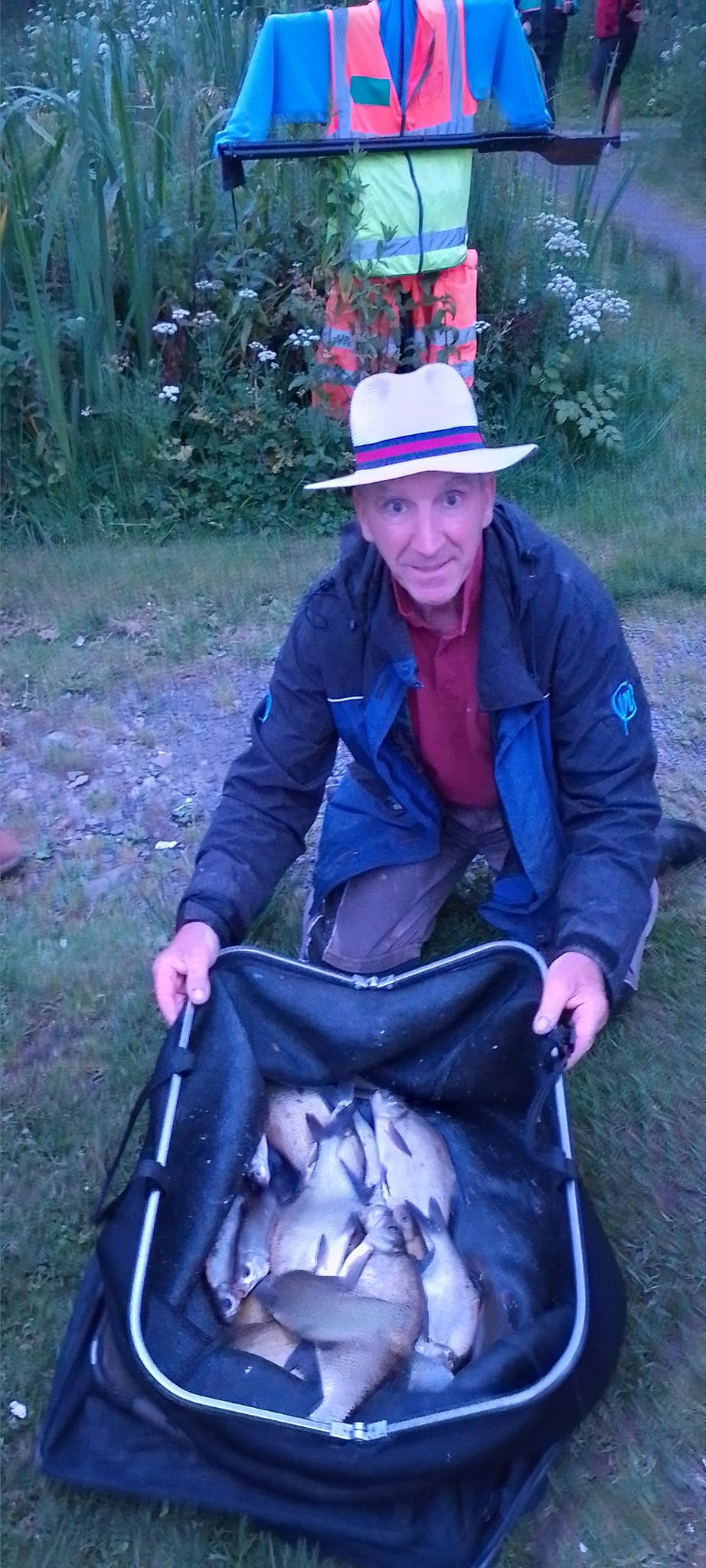
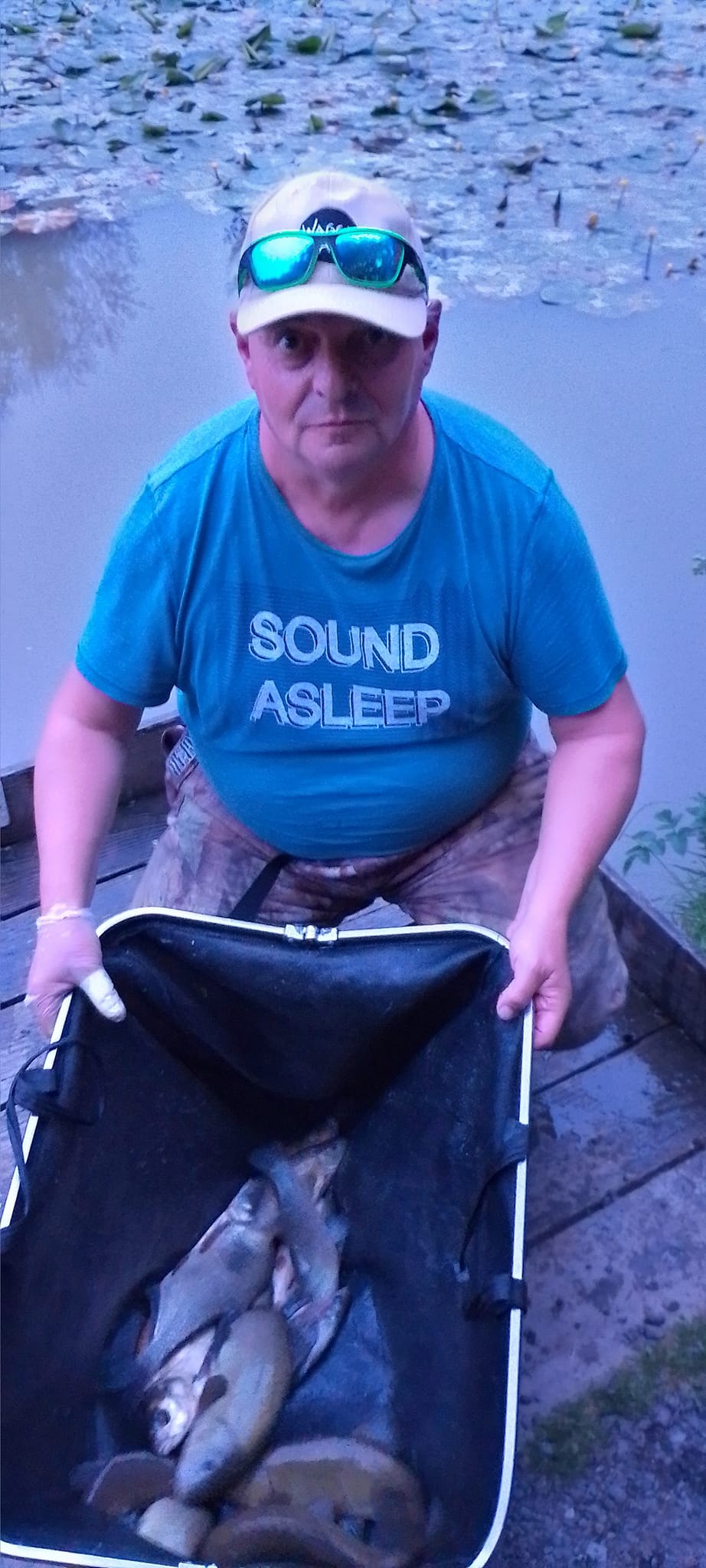


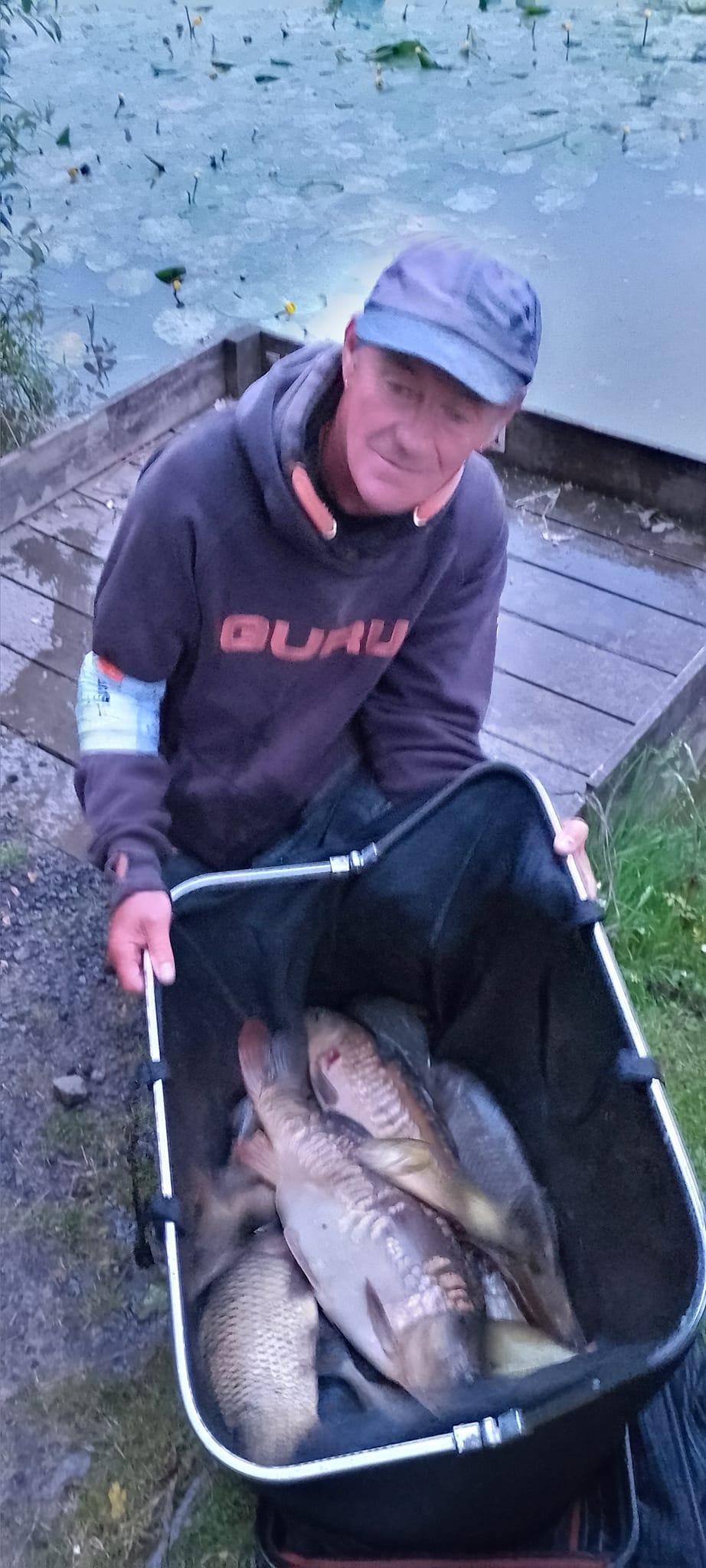
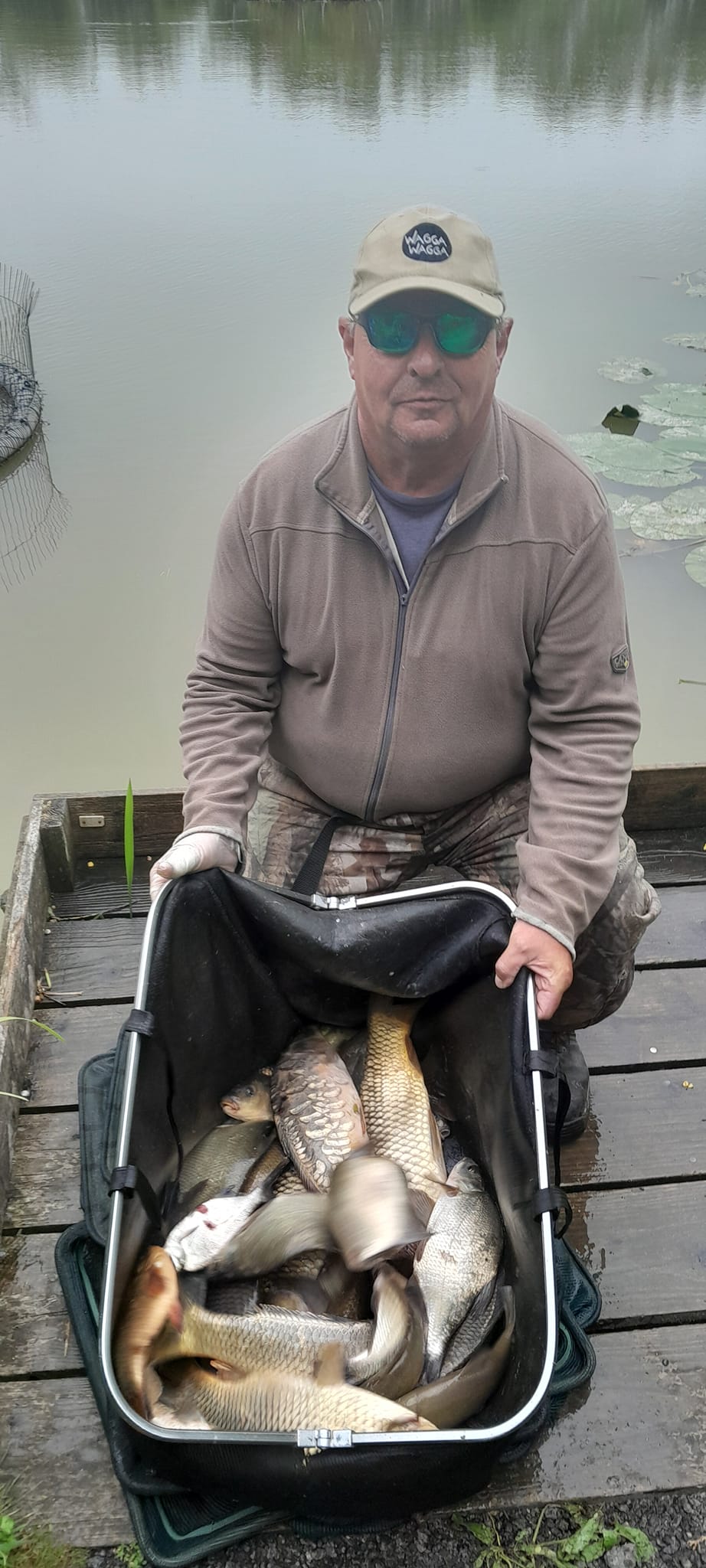
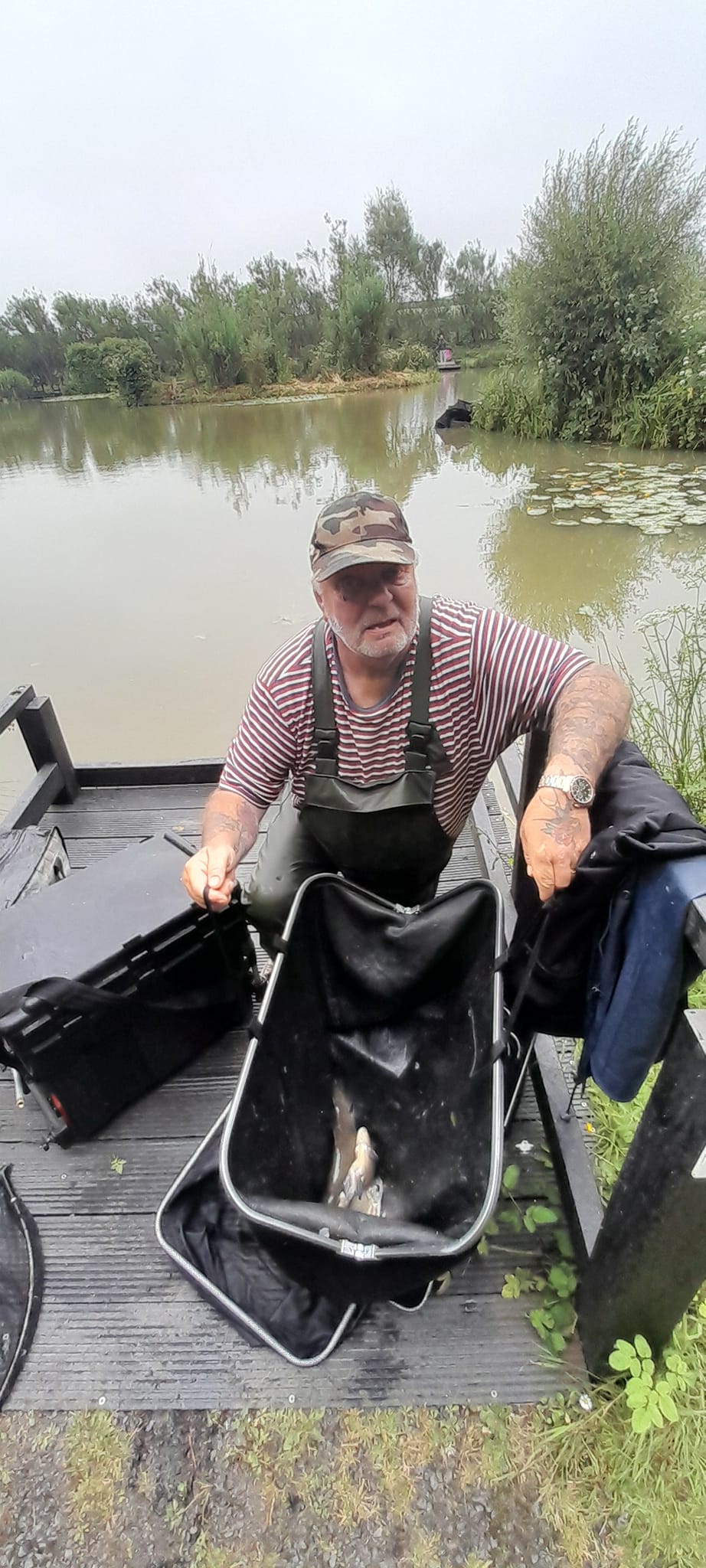
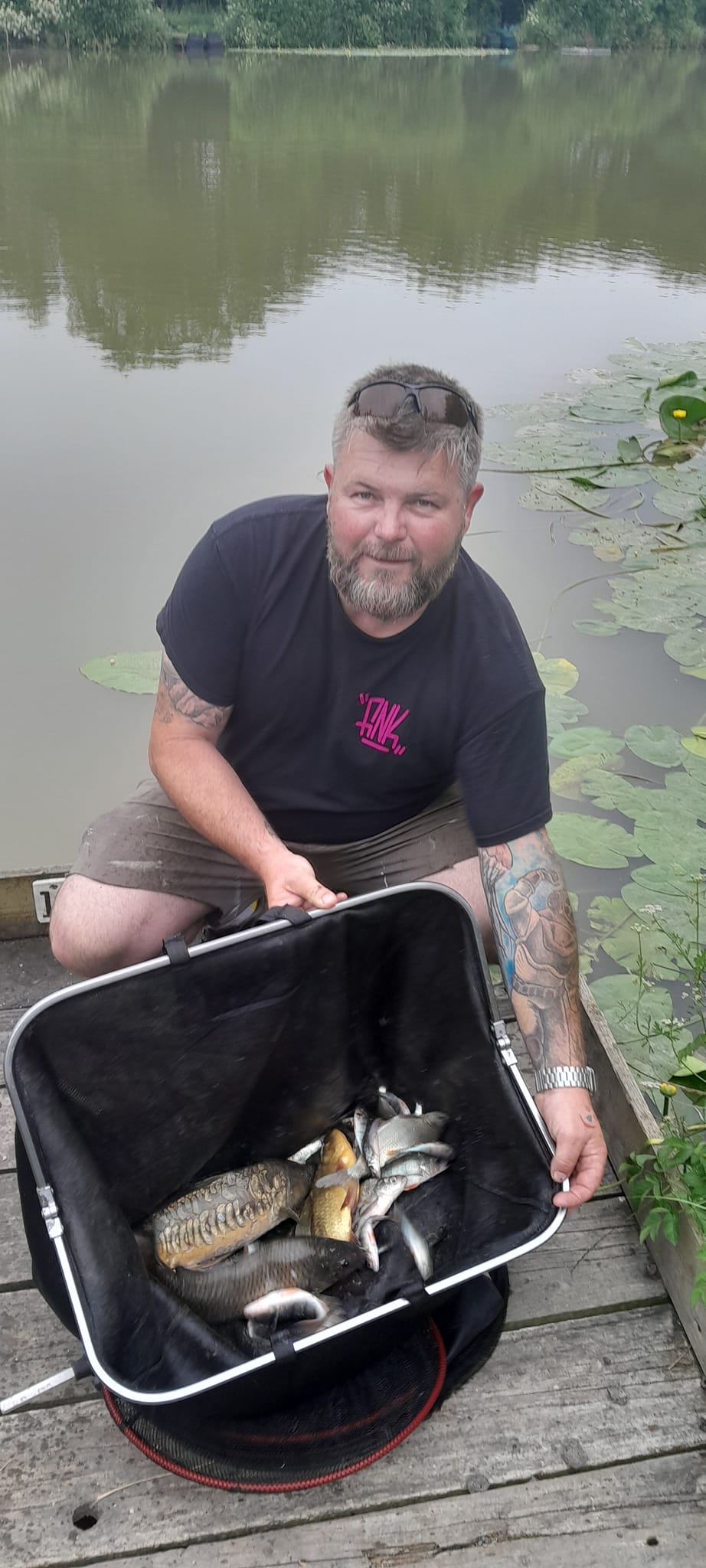
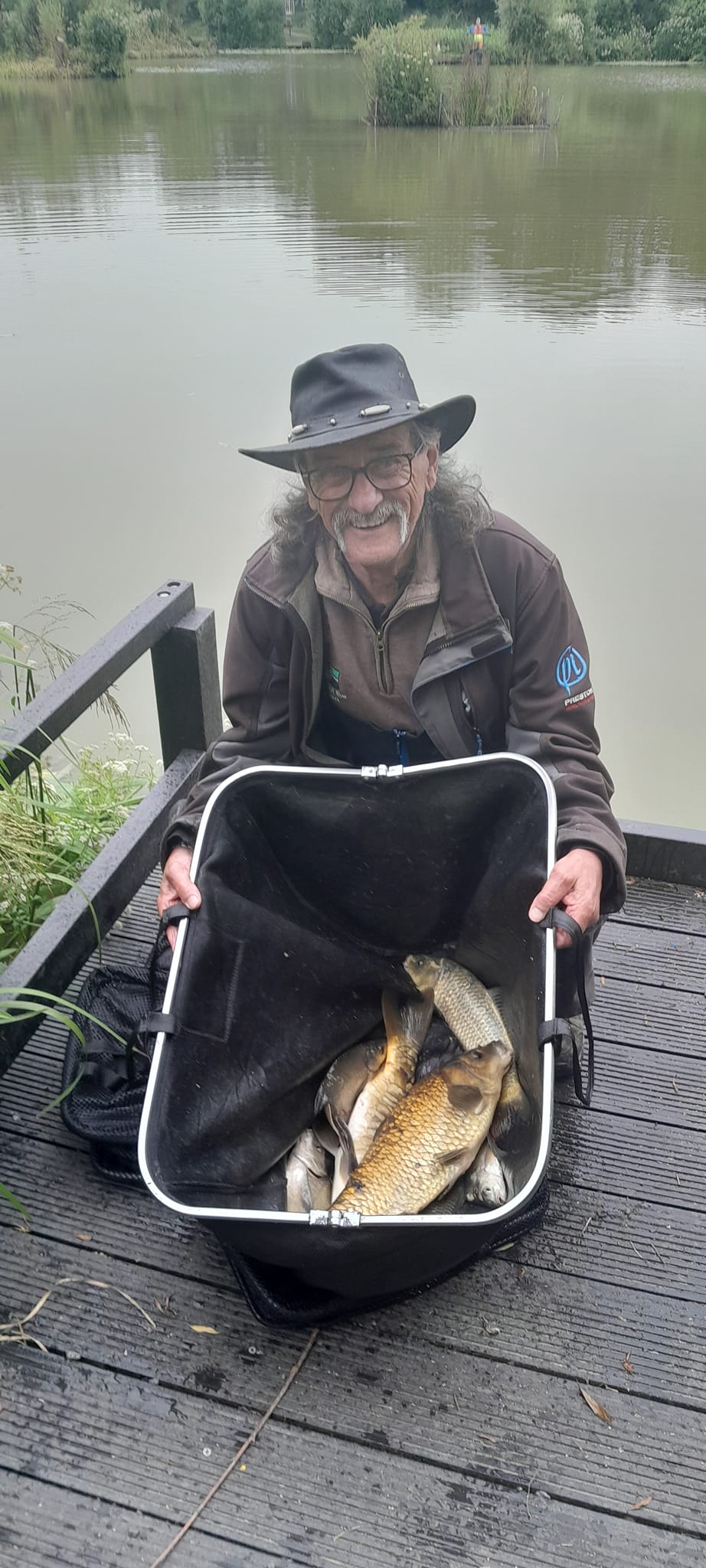
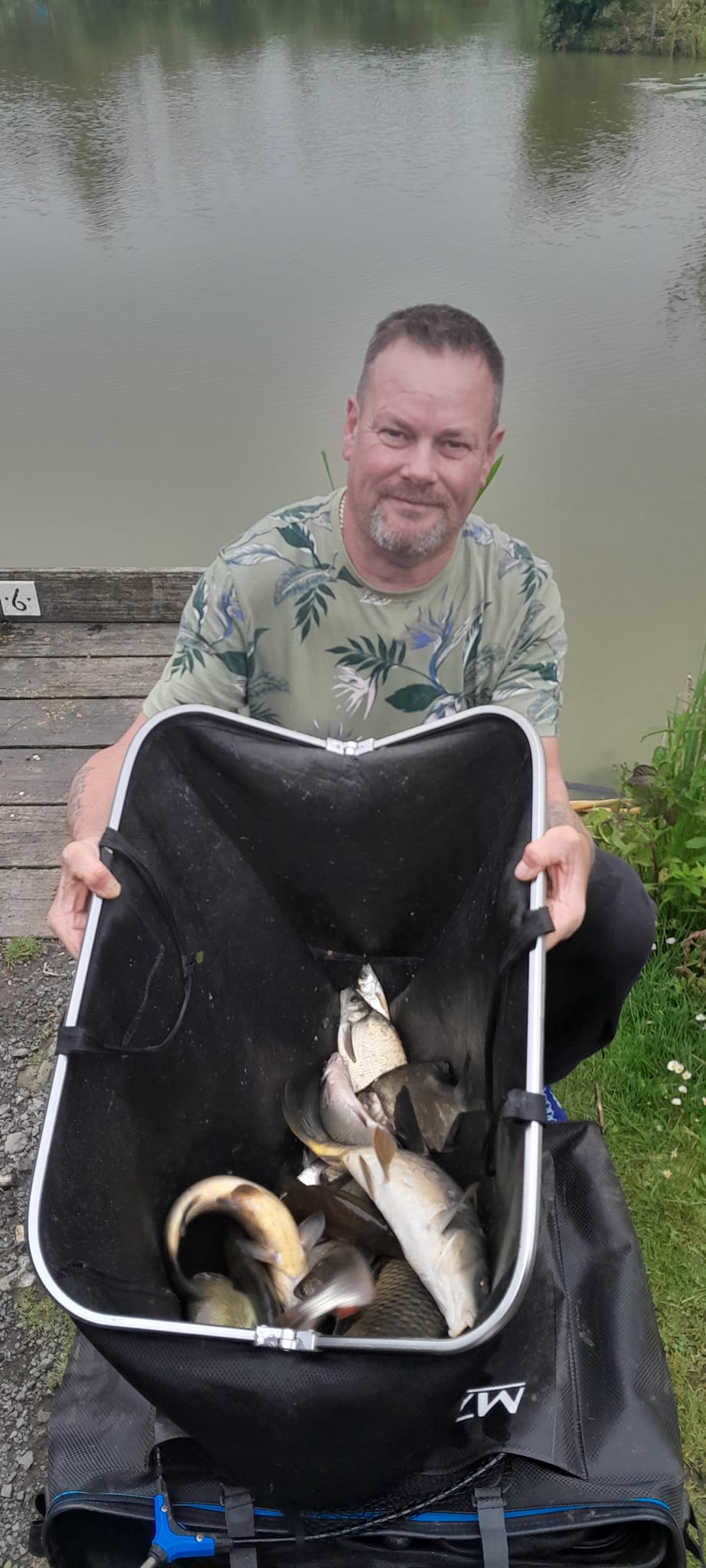
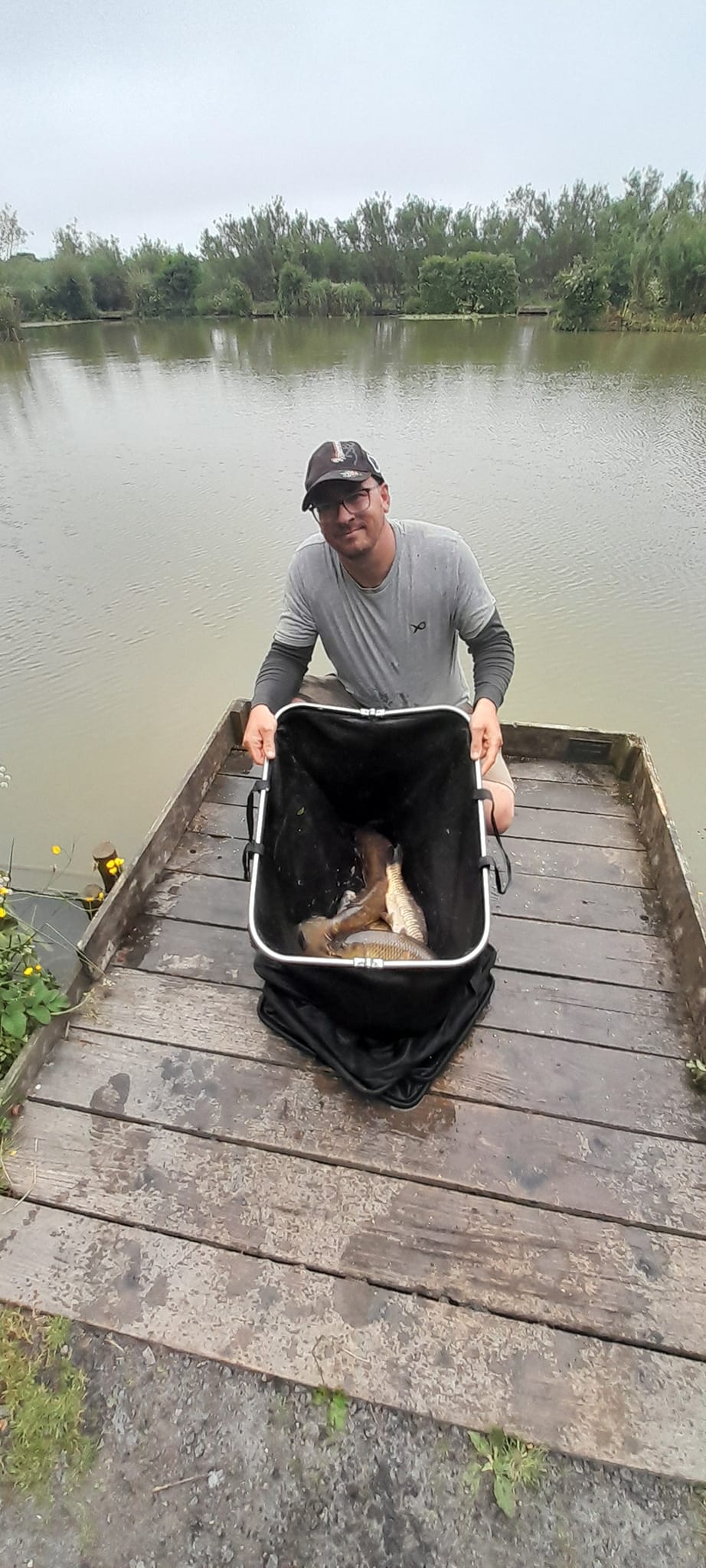
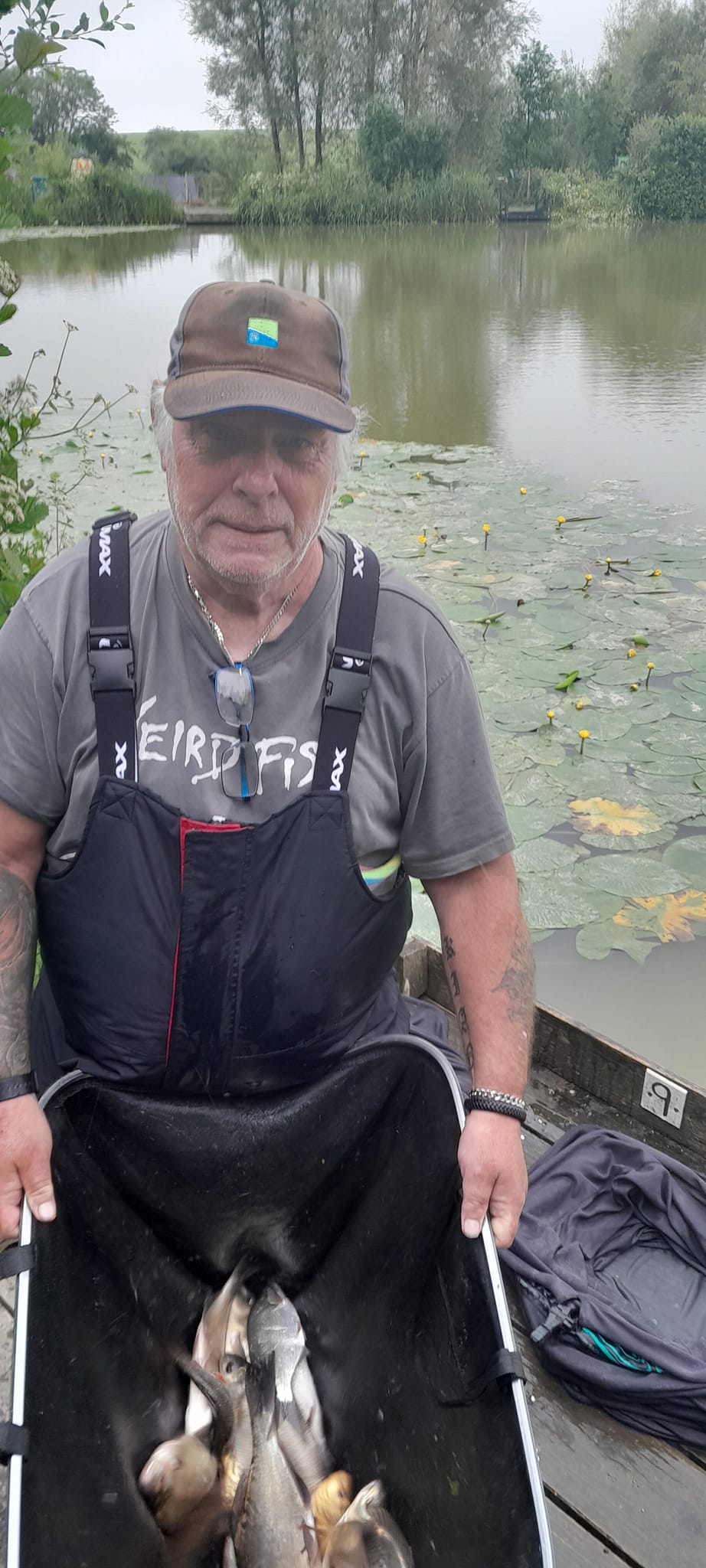
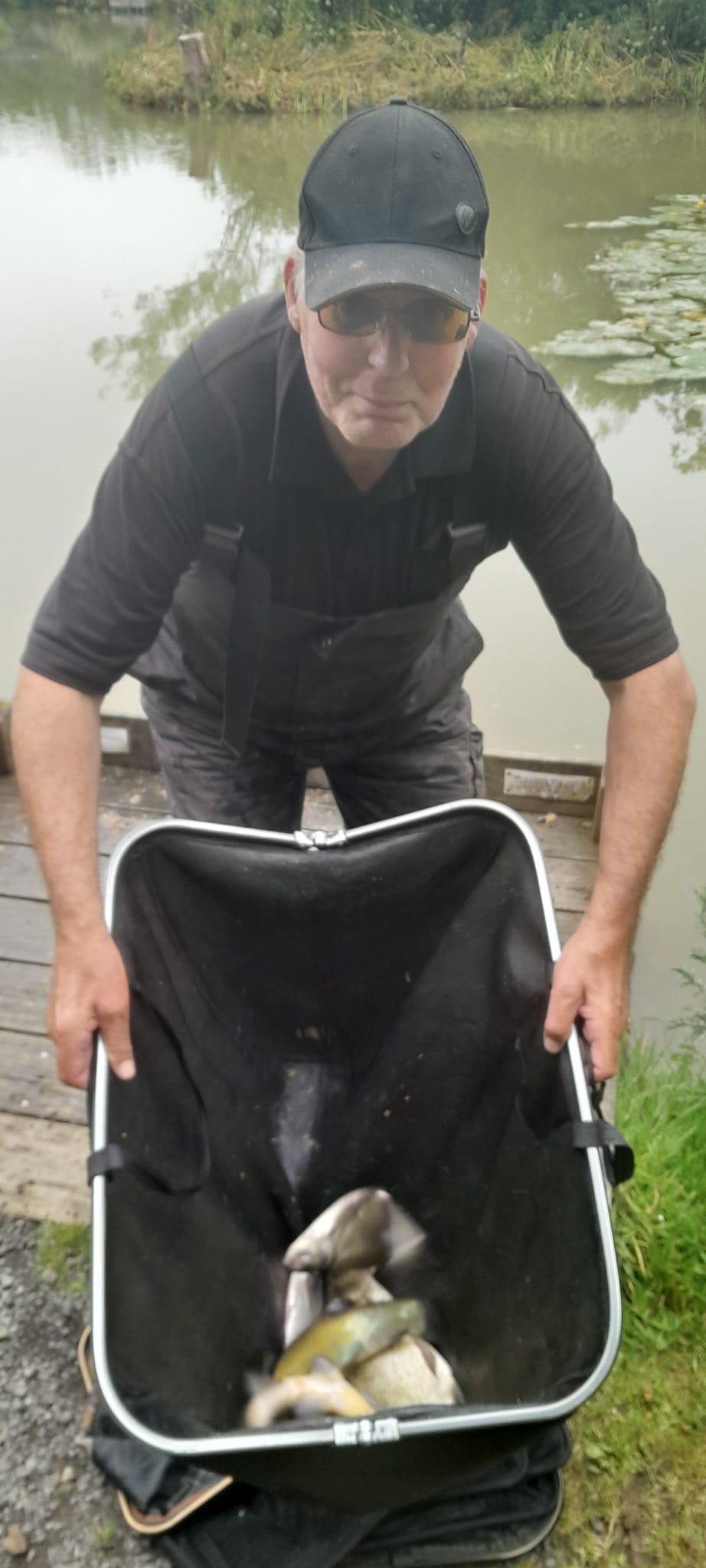
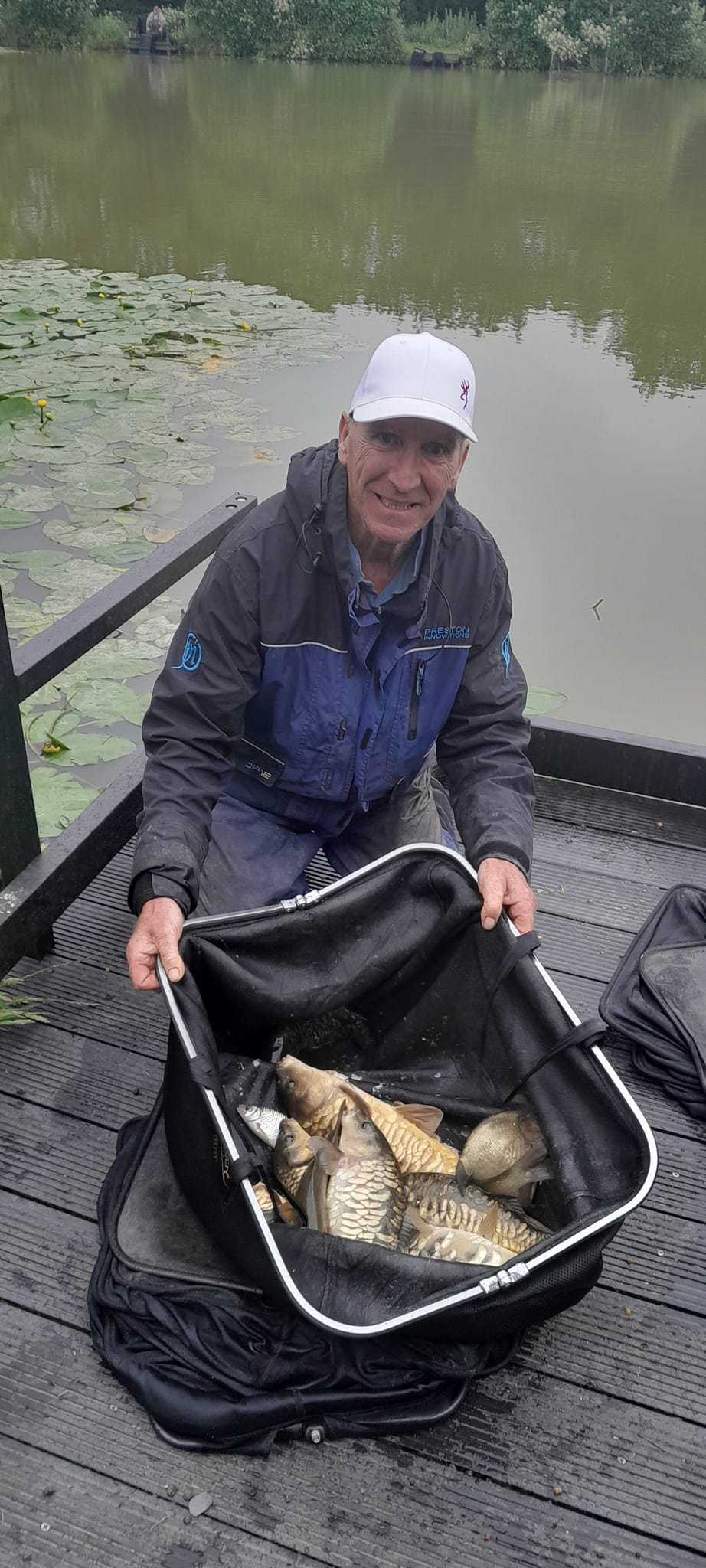
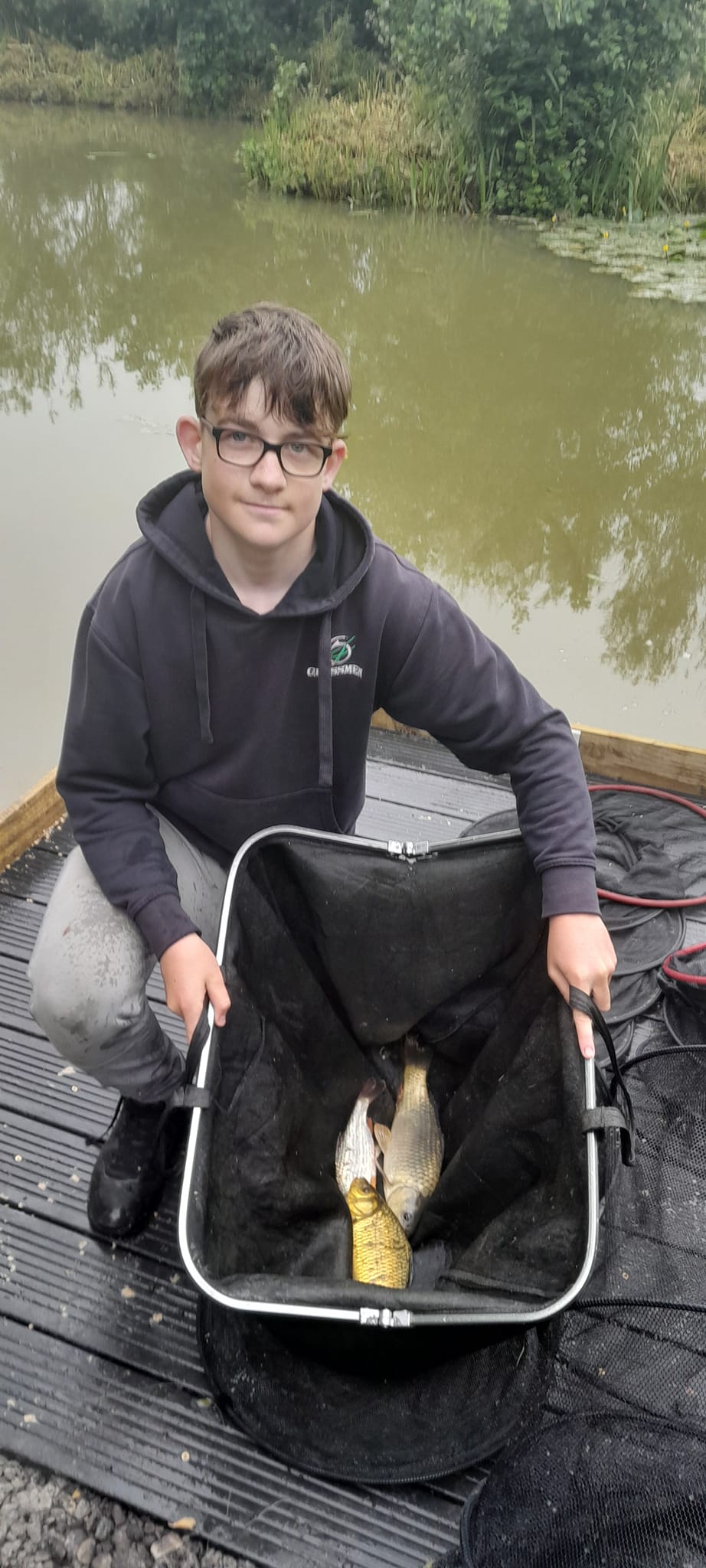
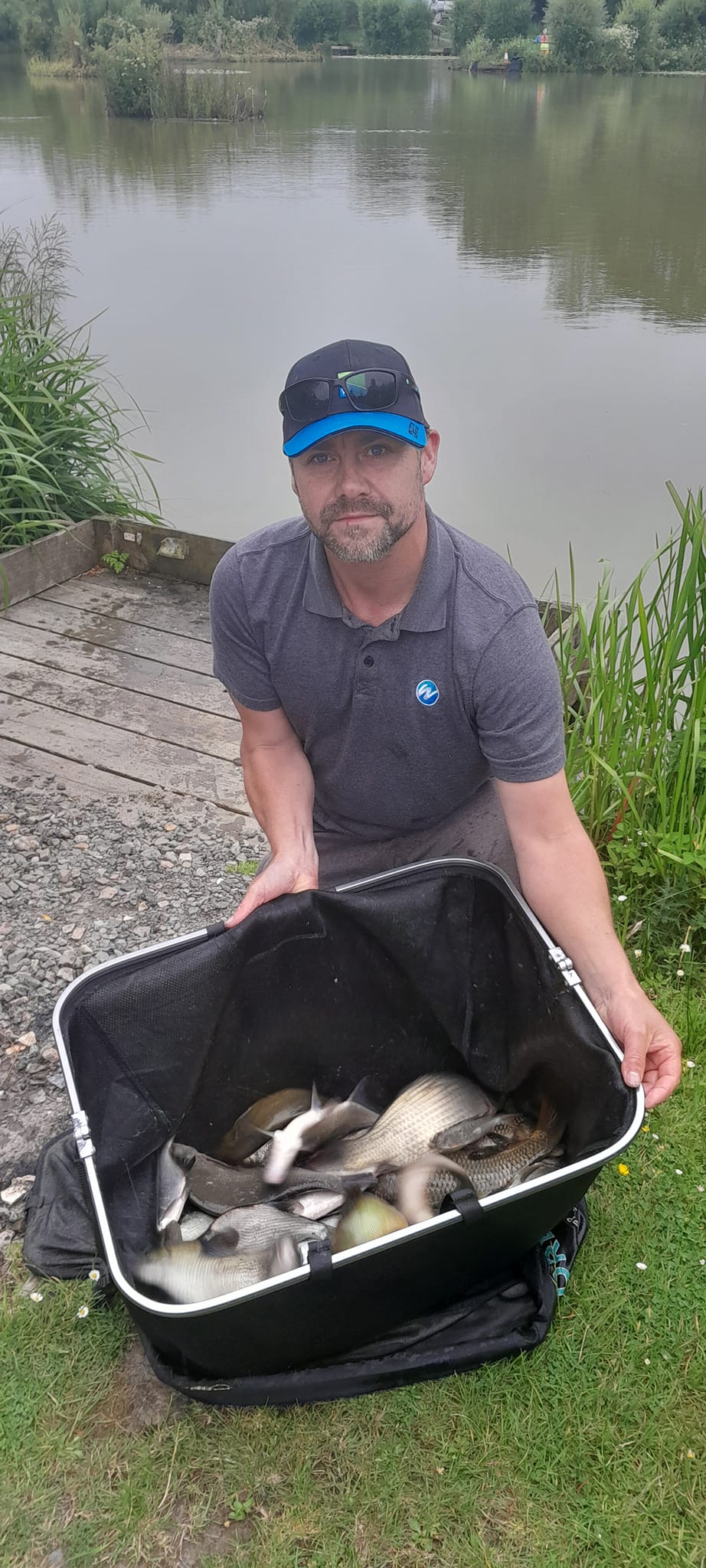
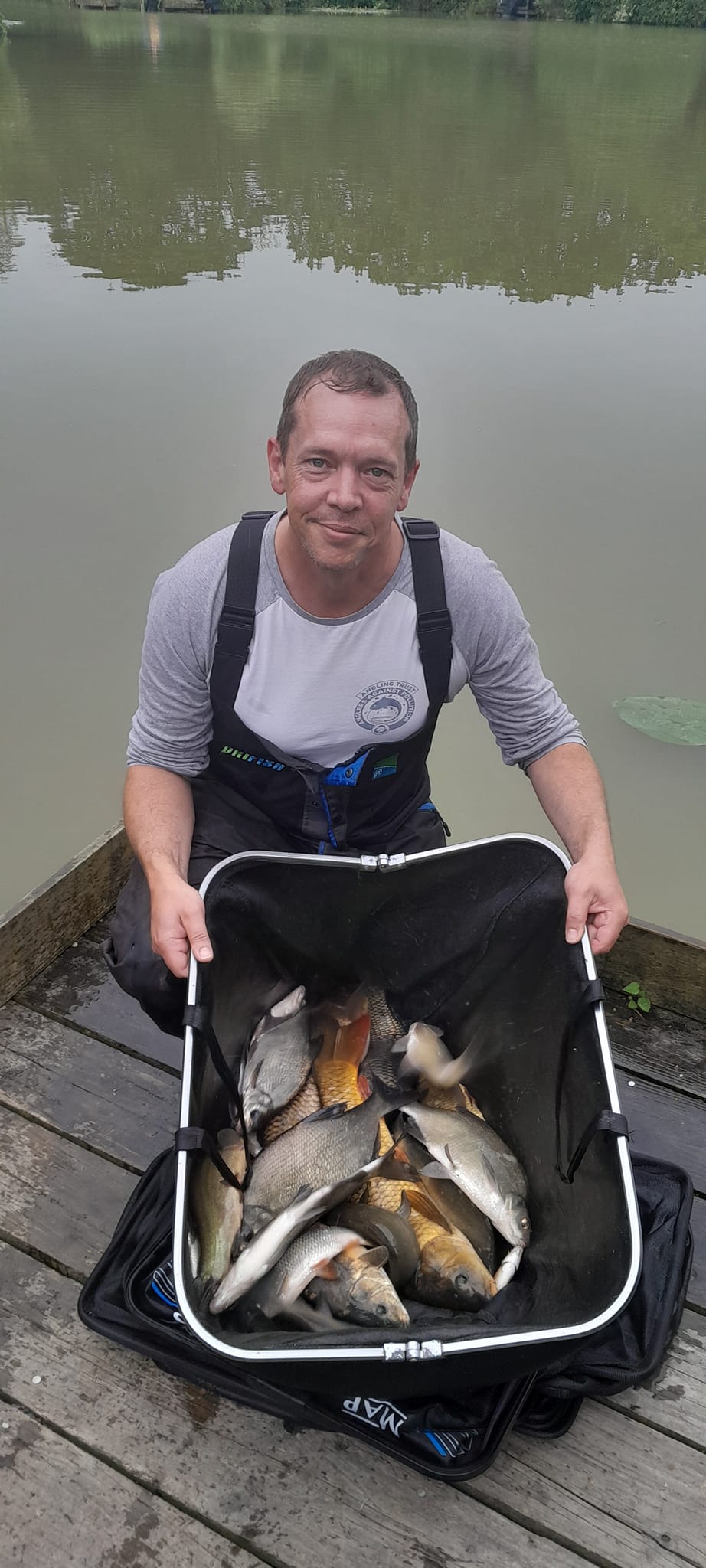


Anglers Eldorado’s Carp and Catfish Lake 2 is renowned for its catfish that have been stocked to over 90lb. It was these powerful and challenging fish that we were targeting on what has become an annual pilgrimage for our group.
Angling is a wonderful pastime for creating long lasting friendships with bonds formed that can often last a lifetime. I have fished with my good friend Bruce Elston on numerous occasions during recent seasons both of us sharing a lifelong obsession with angling.
Bruce invited me to join the catfish hunters at Anglers Paradise a couple of years ago. Our group consists of Mitch Andrews, his son Ben Andrews, John Hughes, Tony Ball, Bruce Elston, Alan Palmer, Richard Bull and myself.
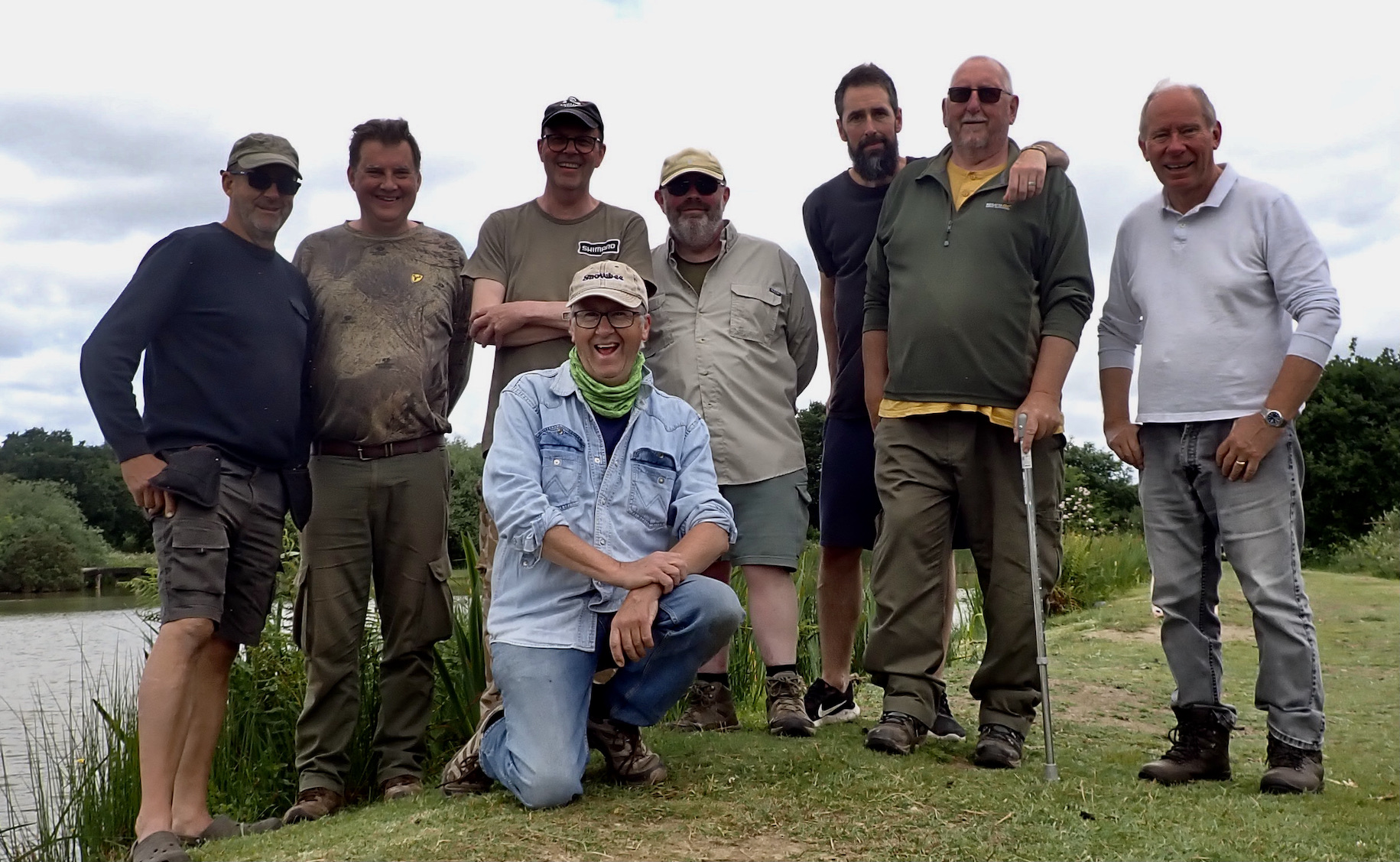
Fishing at the venue runs for twenty four hours from midday. We had booked the lake for two days, forty eight hours to target the big catfish that lurk in the murky waters.
We met up at Bruce’s house for a brunch of bacon, fried egg and fresh bread washed down with tea and coffee. The banter flowed as we discussed tactics and caught up. Strange how we all reconnected after a twelve month gap almost as if we were reconvening after just a week or so.
Bruce had used his extensive knowledge of the venue to draw up a map showing all the productive swims and where the hotspots were. We all drew numbers out of the proverbial hat (oven glove) to decide who would fish where ensuring that those who wished to fish together could. This was all very much a case of everyone getting the best chance and making sure the whole lake was covered as this is a team effort with no intended competitive element.
I ended up fishing the East side of the lake offering a wide choice of known holding spots to cast into.
The first task upon arriving is to lug the mountain of gear required for a forty eight hour session. This is no easy task with barrows loaded to the maximum with two trips required for most.
On arrival in the swim my first task was to set up a rod to explore the swim. Casting a lead and marker float around the swim it is possible to check the depth and assess if the bottom is clear or silty etc.
Where to put the bait is based upon prior knowledge, advice, observation and that all important gut feeling. Two rods are allowed on the lake and I decided to bait up two spots spodding out generous quantities of halibut pellet in various sizes along with a few boilies of the type to be fished as bait. In this case Sticky Baits Krill and Bloodworm.
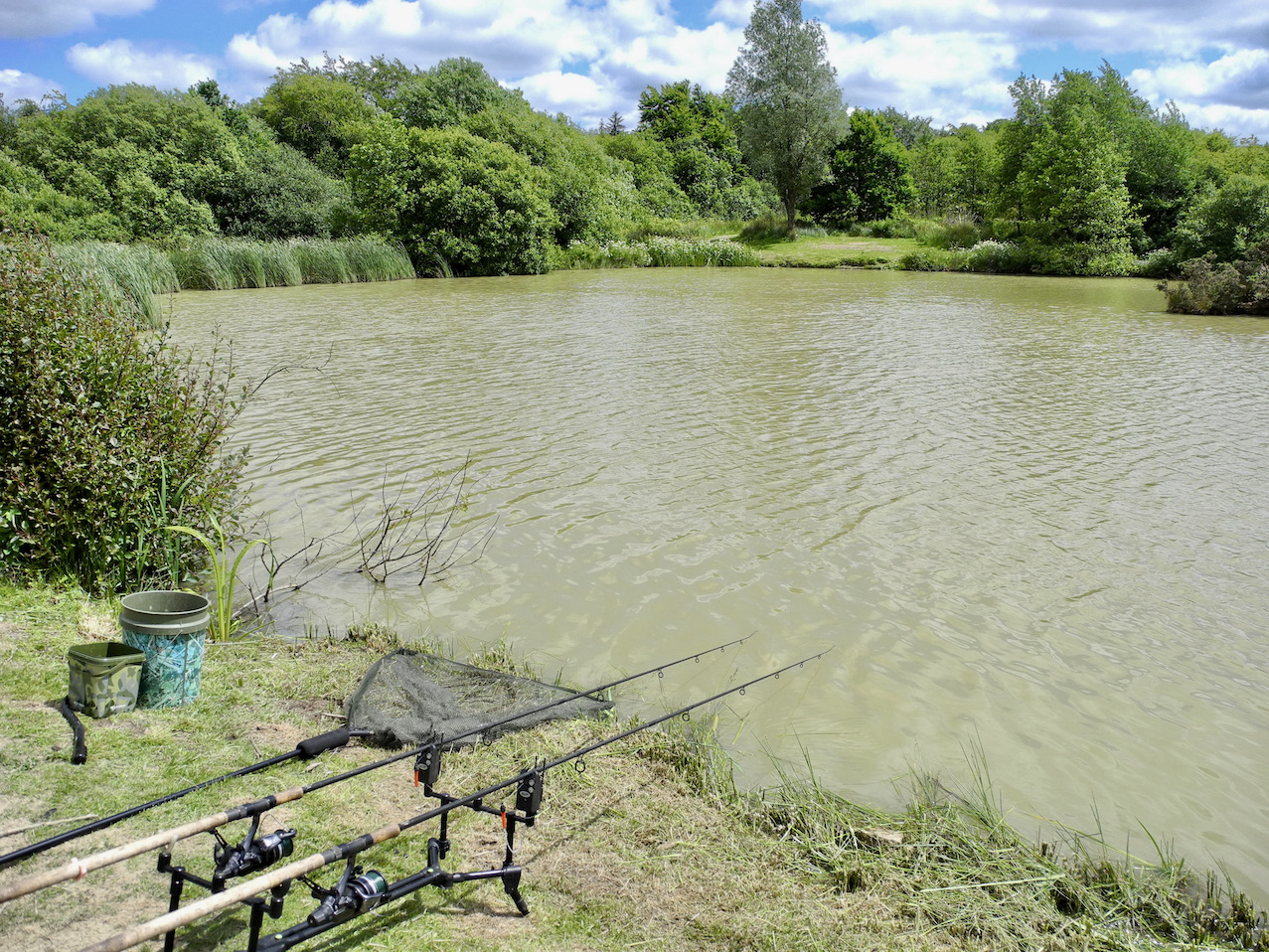
To some extent of course hotspots on these lakes are created by anglers. Spots that look good to anglers are baited up and become feeding spots for the fish. The anglers then catch fish from the spots that become popular with more anglers who add more bait ensuring the ongoing productivity of the hotspot.
We all followed the same basic plan targeting catfish with stepped up carp rigs using boilies and bolt rigs.
This whole branch of fishing is very much a case of setting traps and grabbing the rod when the fish self-hooks itself.
I don’t believe that catfish are particularly rig shy like carp which is a good job as with fish present close to 100lb subtle rigs are not practical.
There is a certain appeal to a long session a chance to relax and settle into the natural cycle of the natural world.
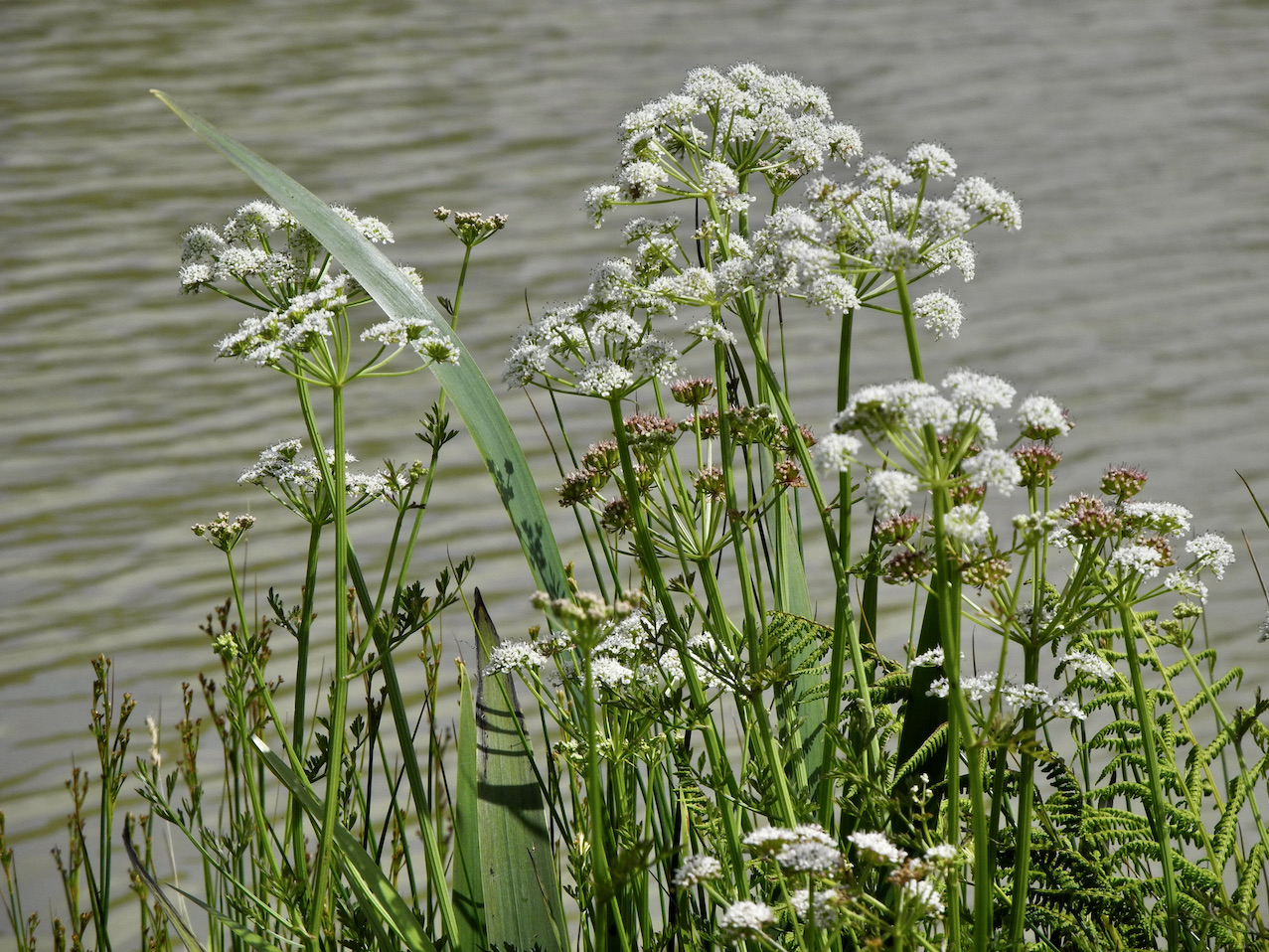
There is a continual sense of expectation and anticipation. At any moment the alarm could sound its harsh blip alerting the anglers as an unseen fish of unknown size tears off with the bait.
Conditions seemed close to perfect. A light breeze drifting high white clouds across the deep blue summer sky. Half a dozen buzzards soared high on thermals their mewing cry’s drifting across the lake. A family of Canada geese paraded around the lake and a mallard brood swam across the water. I thought how vulnerable they looked and wondered if the catfish ever enjoyed a duckling snack.
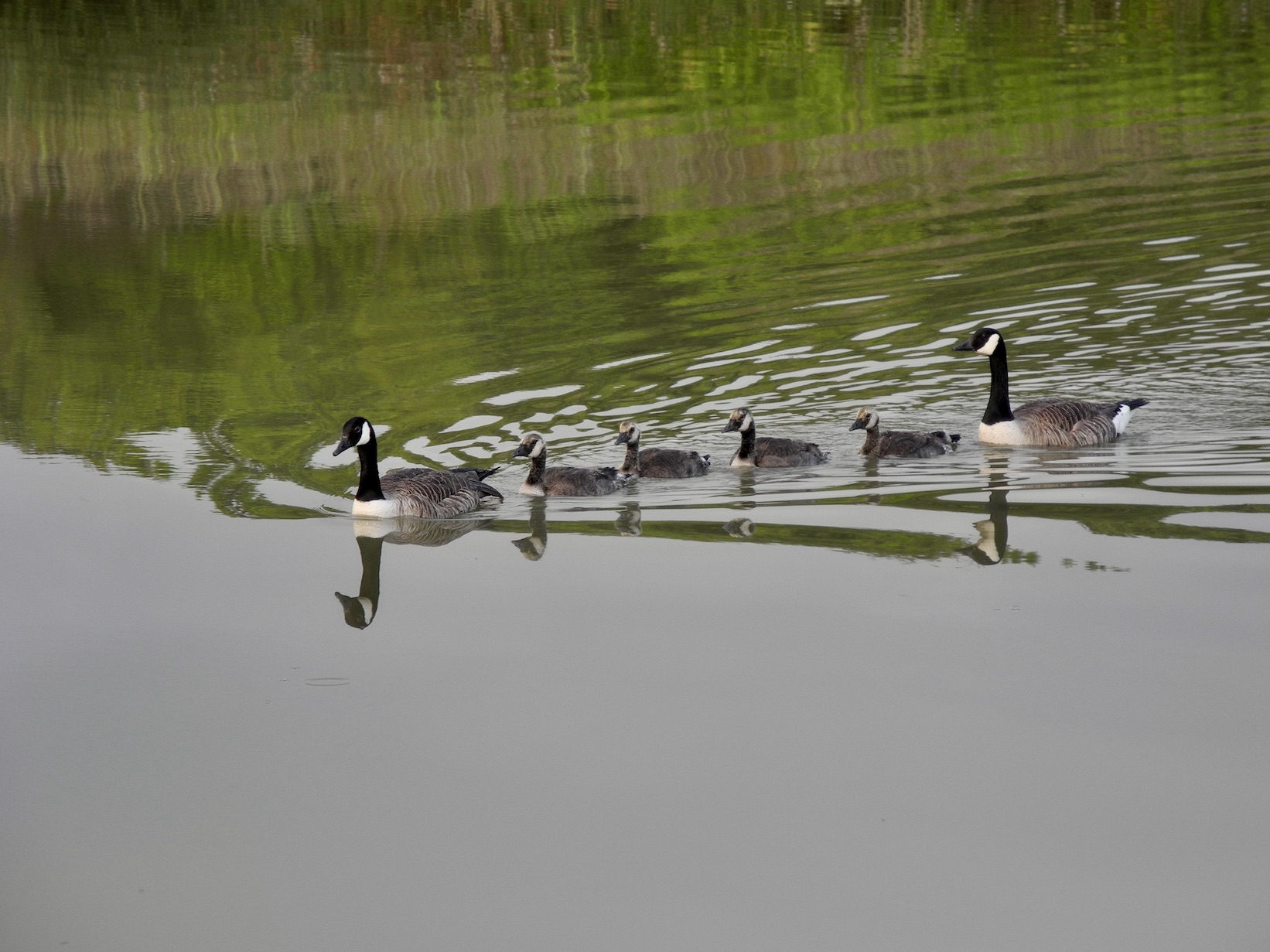
Late afternoon there came a cry of fish on. Ben had hooked the first cat of the session a pleasing start, 21lb.
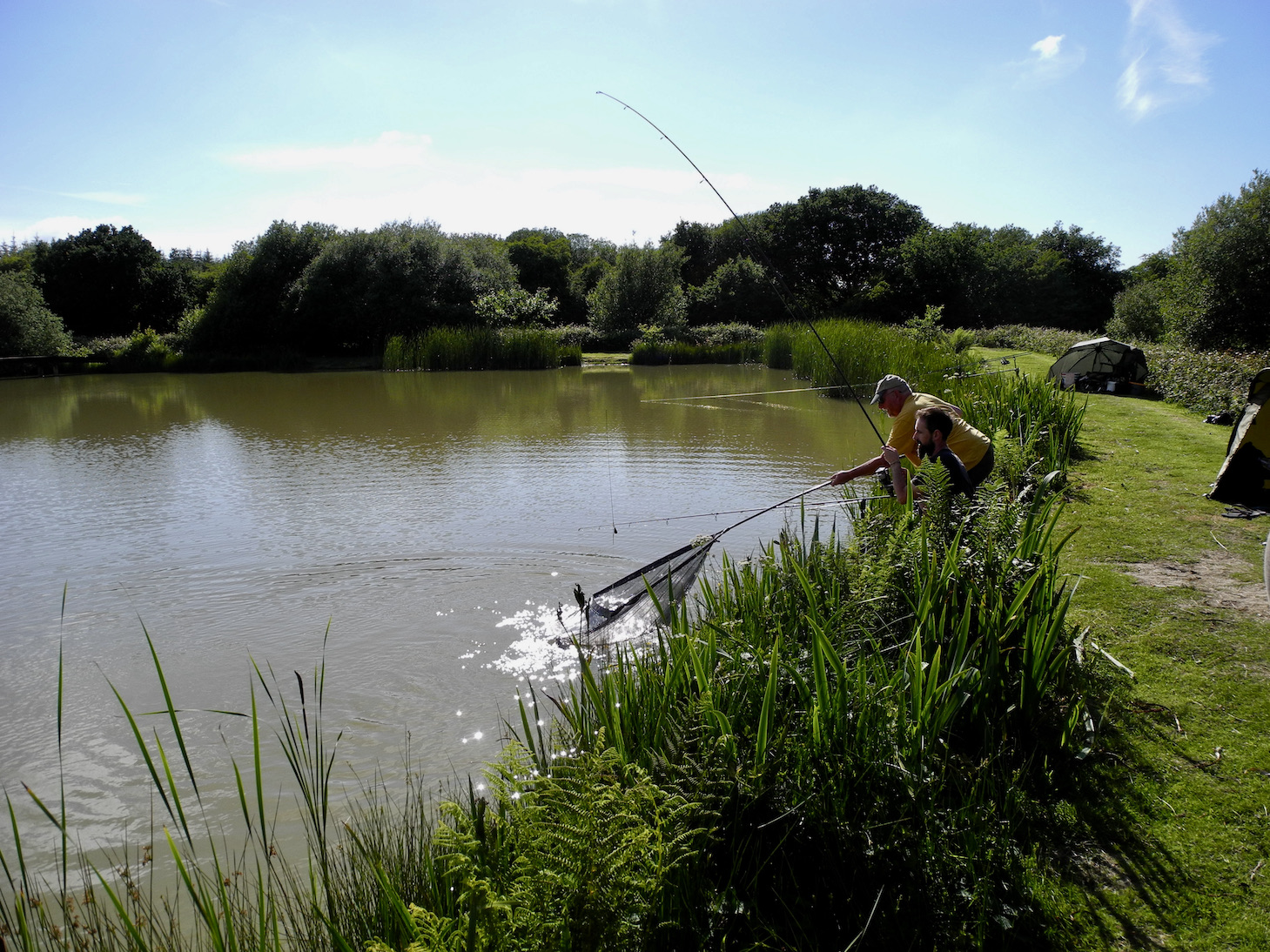
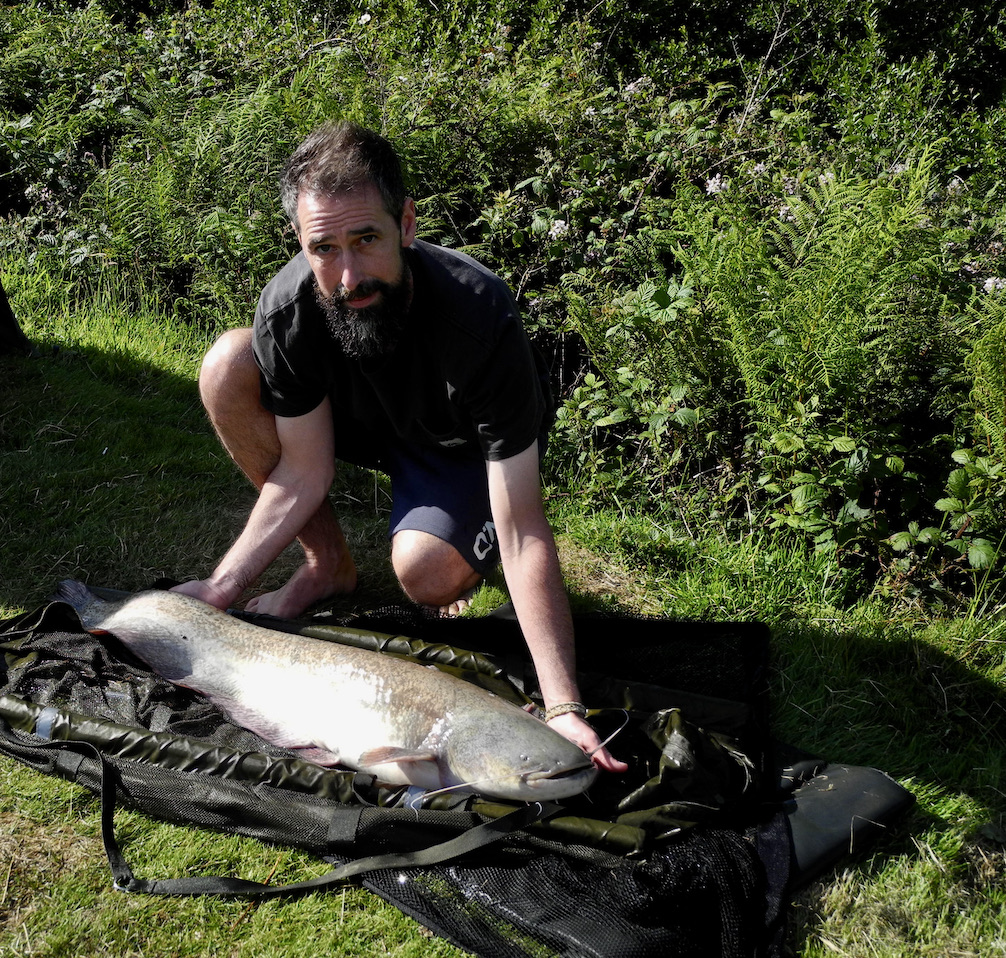
Early evening it was time to stop for a catch up. We all wound in our rods and assembled together to enjoy fresh pizzas delivered bankside to us by Bruce Elston’s obliging family.
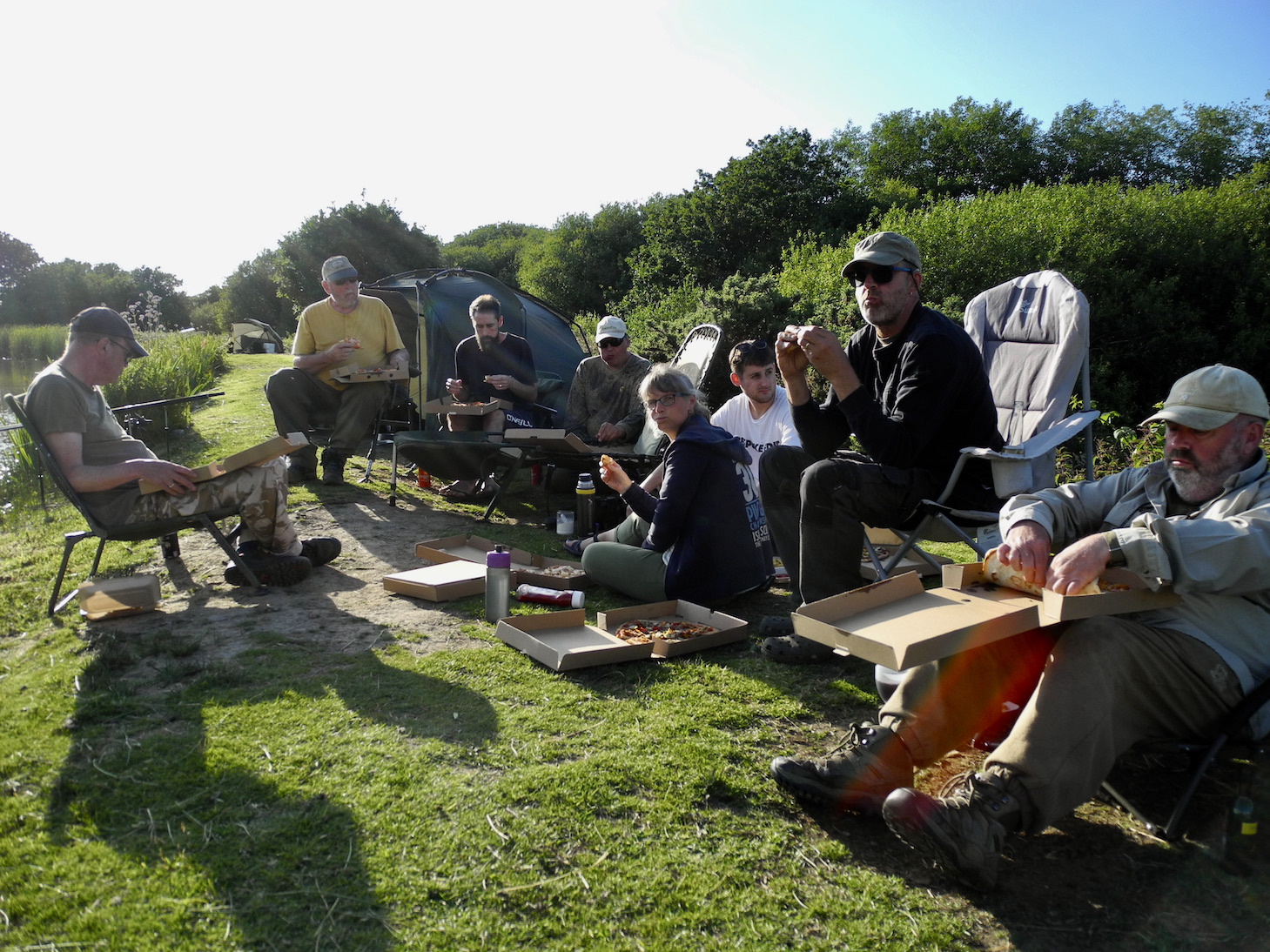
This was an opportunity to catch up and talk fishing and there was as always a great deal to discuss. I had probably last fished with Richard Bull from the Dam wall at Durleigh Reservoir near Bridgwater for pike. Back then we were both young men starting off on life’s hopefully long journey. Close to forty years later we had both retired from long careers, mine in the water industry and Richard’s with the Environment Agency.
A lot has changed in those forty years and we soon started to compare notes along with Alan Palmer. It was immediately apparent that we shared a deep concern regarding the dramatic decline we had seen in nature. We talked of the dramatic decline of salmon and noted the lack of swallows around the lake. The estimated insect decline of 70% over the past forty years, a lack of big pike across the Somerset levels and a collapse in the once prolific population of eels.
As anglers we are of course very aware of what is happening to the natural world. Pesticides, farming practices, climate change and an ever increasing human population all contributing to natures decline.
The conversation drifted onto the state of angling. We are perhaps creatures of our generation and have views created from our journeys. Angling perhaps reflects society.
We all reflected upon how we had started fishing for small fish serving a sort of apprenticeship before progressing to bigger specimens. It seems that many of todays young anglers arrive at the water’s edge with all the gear setting out to catch twenty pound carp straight away. Instant gratification no slow path to success. I want it all and I want it now!
We looked back fondly at our days as young specimen hunters. A time when we learned from books and pooling knowledge. No you-tube videos and ready-made rigs.
Richard reminisced about his fishing for catfish at Claydon Lake in Bedfordshire during the late eighties and early nineties. The catfish that resided in the lakes had been transferred from Woburn Abbey Lakes. Claydon Lake is situated within the grounds of a large country mansion. The large catfish were a target for budding specimen hunters of the day. Richards best catfish from the water was 35lb a fish that was at the time within the top ten catfish caught from UK waters.
We discussed Claydon Lake and other venues like Redmire Pool. Waters that have a unique status in angling history. There is perhaps a certain nostalgia amongst our generation a longing for the mystery and excitement of a bygone era.
Whilst we had discussed the undoubted decline in nature we also had to acknowledge the fact that many fish now grow far bigger. We were fishing in a lake that contains a large number of catfish far in excess of the wildest dreams of anglers back in the 1980’s. Catfish of over fifty pounds now fail to warrant a mention in the national angling press. Several waters in North Devon contain carp equivalent to the stocks that resided within Redmire’s hallowed waters.
The eel record has just been beaten, as has the roach record. Many of the British freshwater fish records have been eclipsed in recent years. The roach record is now over 4lb. The bream record stands at 22lb 11oz; I doubt many believed bream could grow to that size back in the 1980’s. The carp record is now 68lb 1oz, catfish record 143lb 14oz, perch 6lb 3oz, pike 47lb 5oz, tench 15lb 3oz, barbel 21lb 2oz, chub 9lb 5oz, crucian carp 4lb 12oz, dace 1lb 5oz, rudd 4lb 10oz and zander 21lb 5oz. All of the above records and several others have all been caught since 2000 proving perhaps that our perception of fishing’s golden era is all within our imagination.
The truth with our perception is perhaps that we have lost much of the mystery and magic? The fish are growing bigger because of an artificially created environment. Whilst truly wild fish like salmon, sea trout and eels are in an alarming spiral of decline other fish dwelling in lakes or rivers enriched by nutrients and anglers baits are growing larger.
In light of the above facts it is undoubtedly our perception of fishing that has changed. A generation is inclined to look back with rose tinted glasses, the measure of success in angling is to be measured in happiness and contentment not in the size of fish. I often state that anglers go through three main phases. At first wanting to catch fish, any fish. Then aspiring to catch bigger fish or more than other anglers. I suspect that at some point most anglers reach the stage where they are content to just go fishing. It is perhaps difficult to reach the latter stage without experiencing the first two. And as stated earlier a modern society tends to skip the first stage and go straight in to stage two.
A fact I often note is that when a bunch of anglers get together a schoolboy humour is soon rekindled as farts and bodily functions always abounds. A youthful cheer emerges which is undoubtedly one of the reasons angling is so good for mental health.
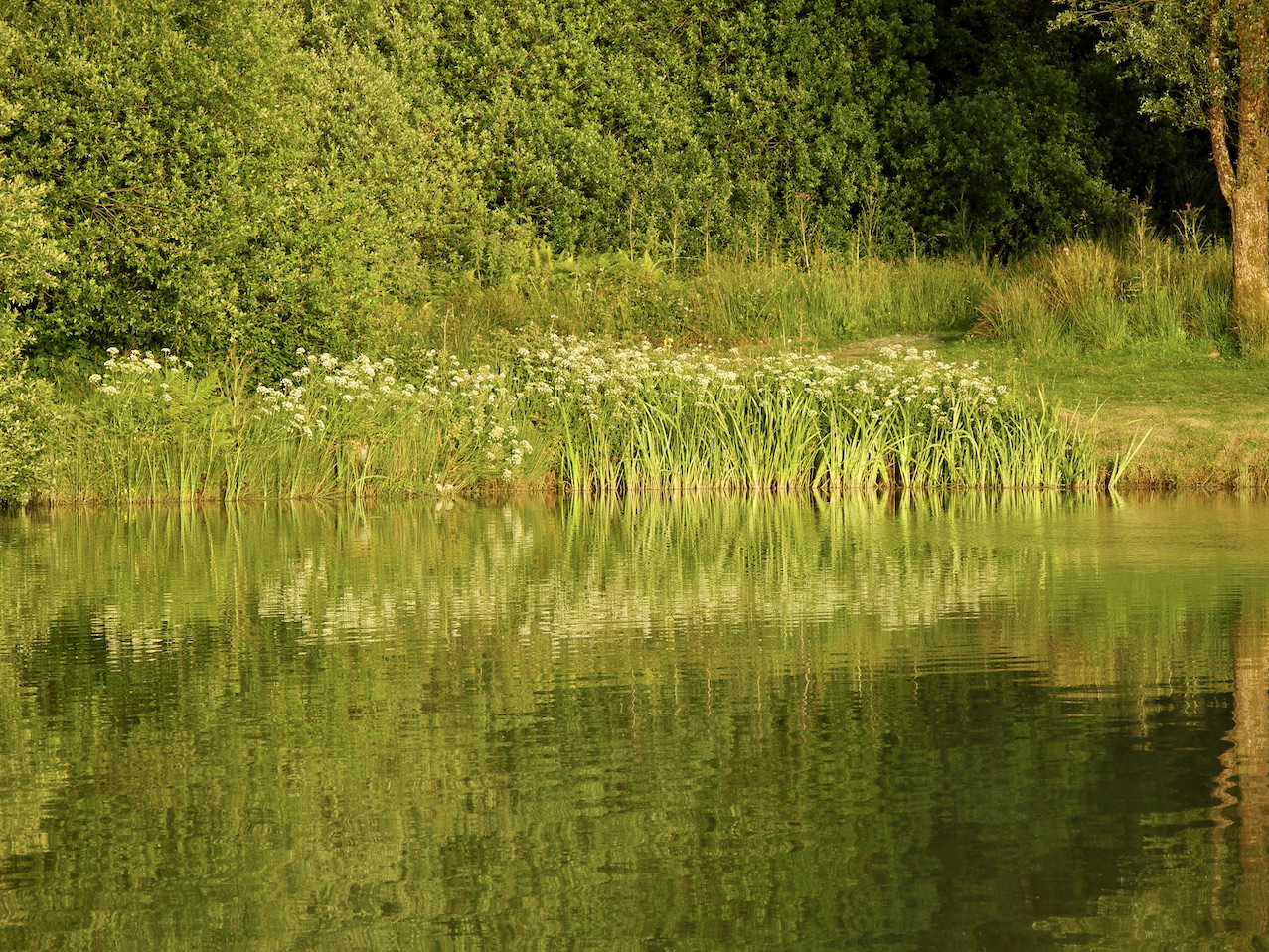
Anyway after a rather long ramble away from our trip I will reconvene on the banks of carp and Catfish 2.
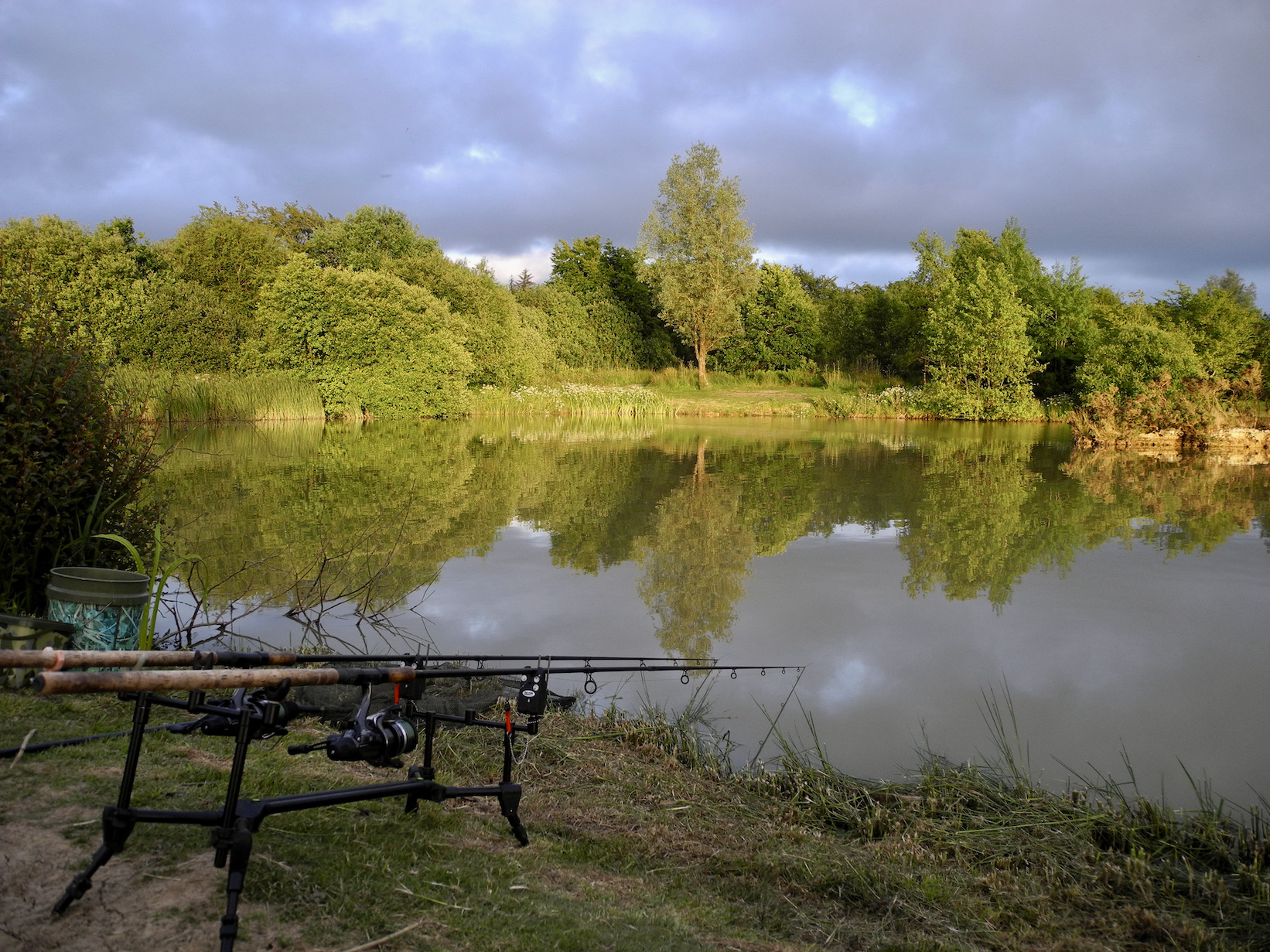
The evening light descended and expectation climbed. At close to midnight my alarm screamed out and I fumbled my way to the rod. Lifting into a heavy fish for a moment or two before the hook hold gave way.
Disappointed I recast and tried to get some sleep. A few hours later at just after 3.00am I heard voices and commotion across the water. Assuming that Bruce or John had caught I reeled in my rods and made my way over to the far side of the lake.
A jubilant John was being congratulated on successfully banking a large catfish. I joined in with the jubilation witnessing the weighing of a personal best cat for John of 49lb. I secured a few images and watched the fish gently lowered back into the lake.
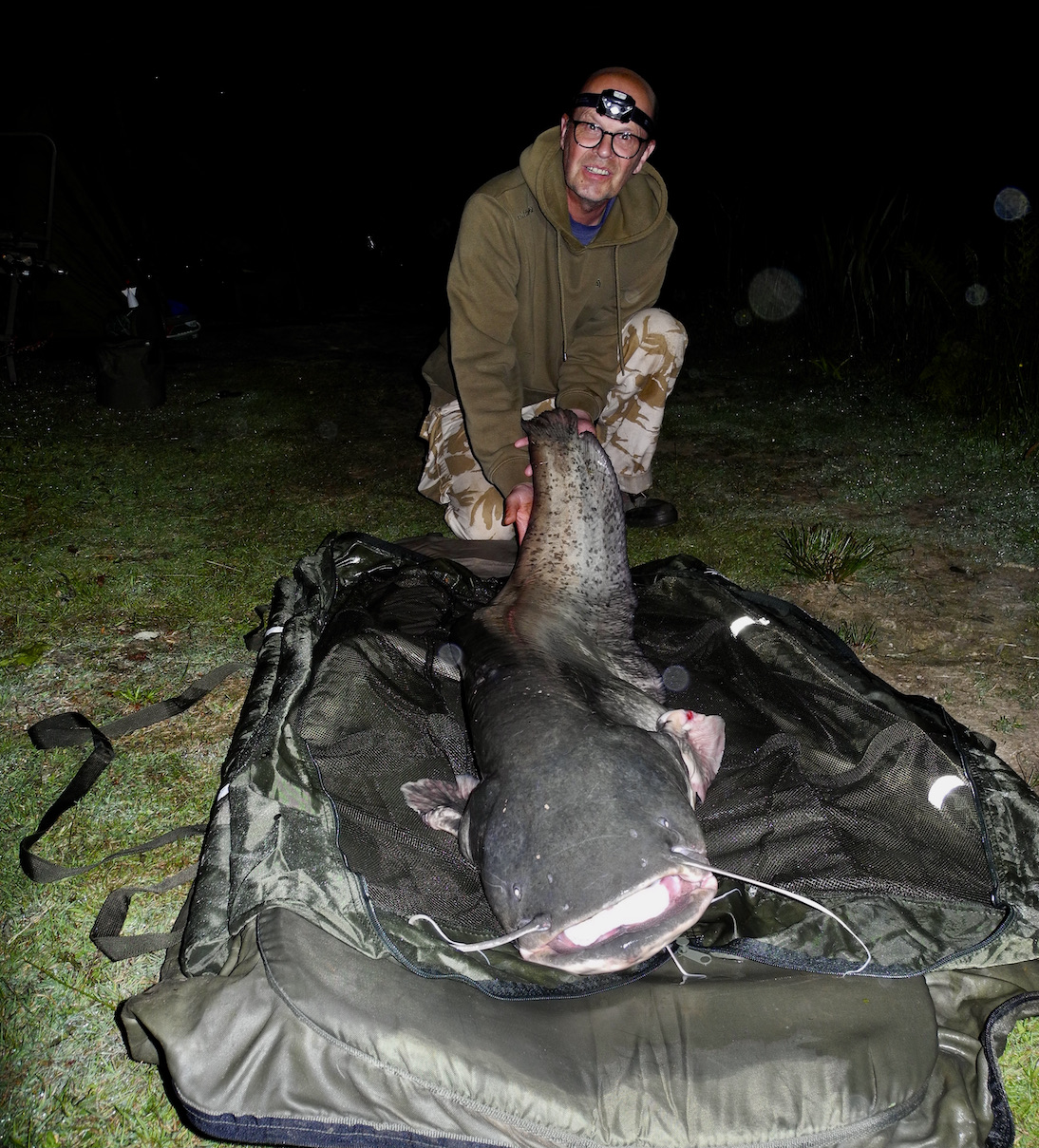
The rest of the night passed by without interruption except for the invasion of my swim by the geese family shortly after first light.
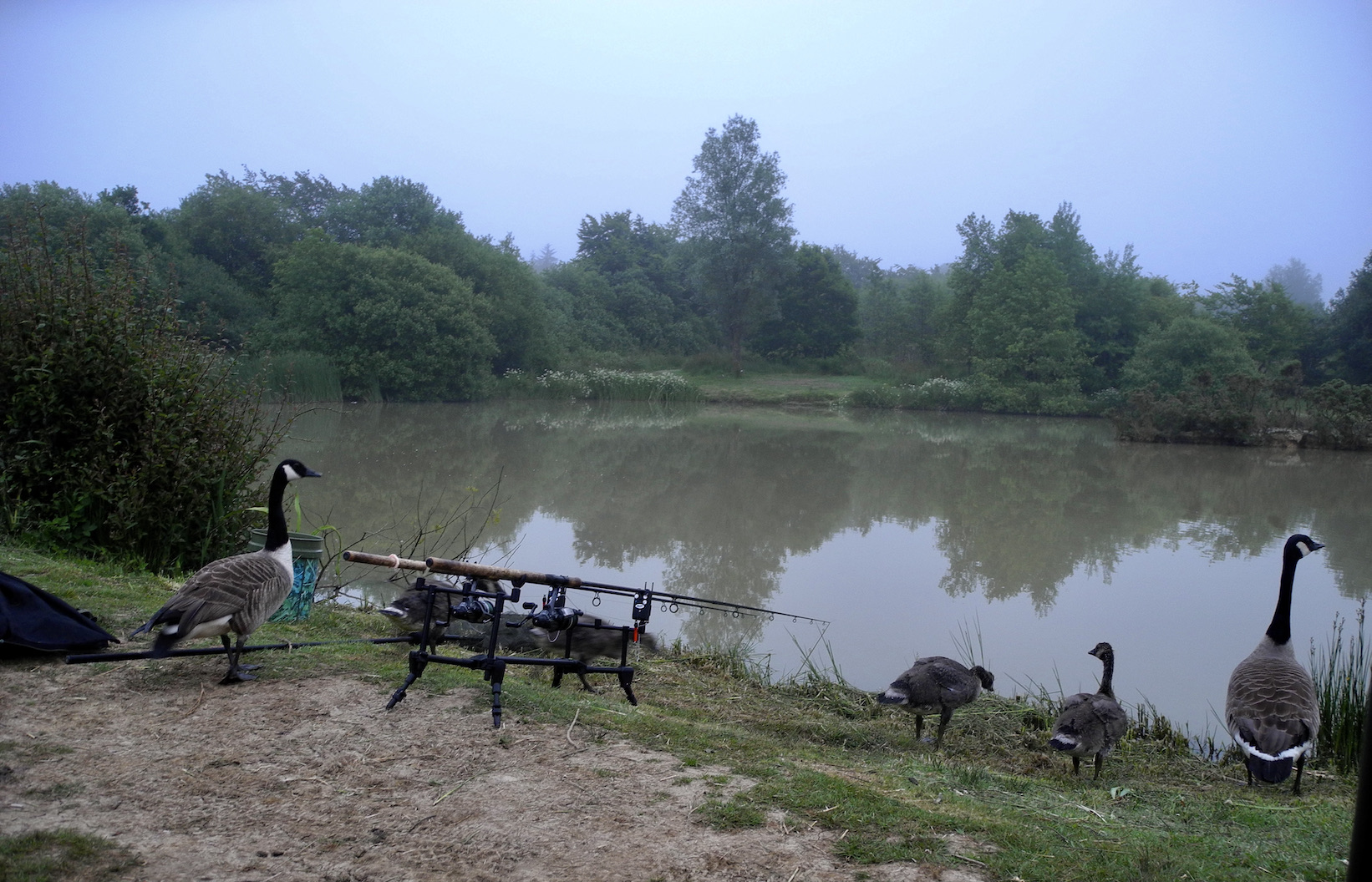
The dawn chorus was spectacular with a wide variety of birds contributing to the choir. The Merlin app on my phone recorded sedge warbler, carrion crow, chaffinch, wren, willow warbler, blue tit, chiff chaff, song thrush and nuthatch.
The second day drifted past and we settled into life on the lakeside. The sound of cars and farm machinery came from the nearby road reminding us of a world beyond this tranquil lake.
Knowing the size of fish present within the confines of this small lake ensured that hope of connection was never lost. I brewed regular coffee and ensured that a steady trickle of bait was going into the chosen spots within the swim.
I noticed the occasional large swirl in my swim, an indication that big fish were on the prowl. But the alarms remained silent.
As evening descended once again expectation grew surely more catfish would be caught? At around midnight my alarm bleeped frantically and I rushed from my bivvy to grab the rod. As I touched the rod handle the run stopped!
In the early hours I was answering natures call and noticed headlights further along the bank. Rich was elated to have landed a catfish of 39lb a new personal best and I believe his first catfish since the mid- nineties.
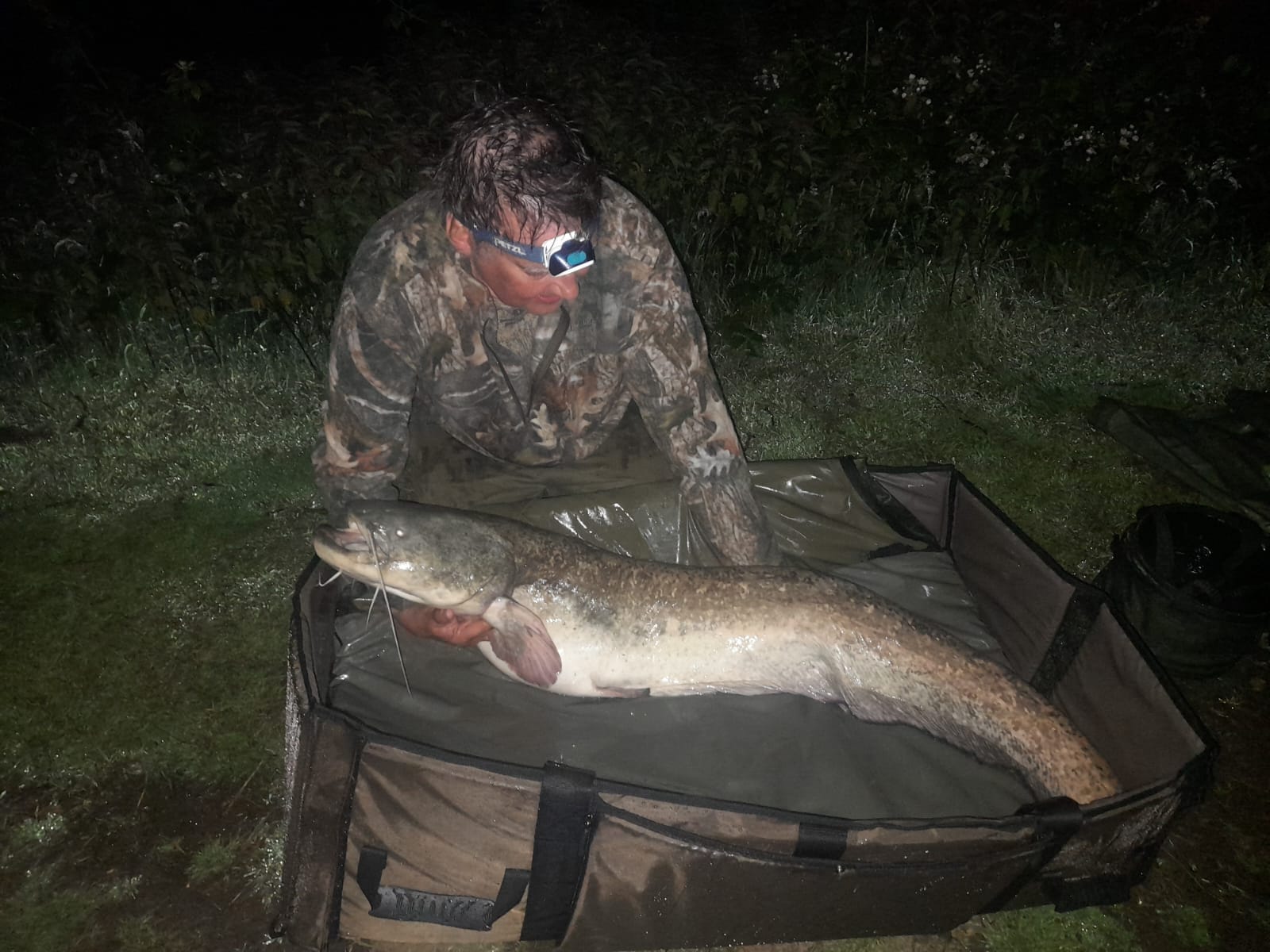
During the night light rain had fallen, resulting in droplets glistening as the new day dawned. The calm light of dawn descended upon the lake as the new day unfurled.
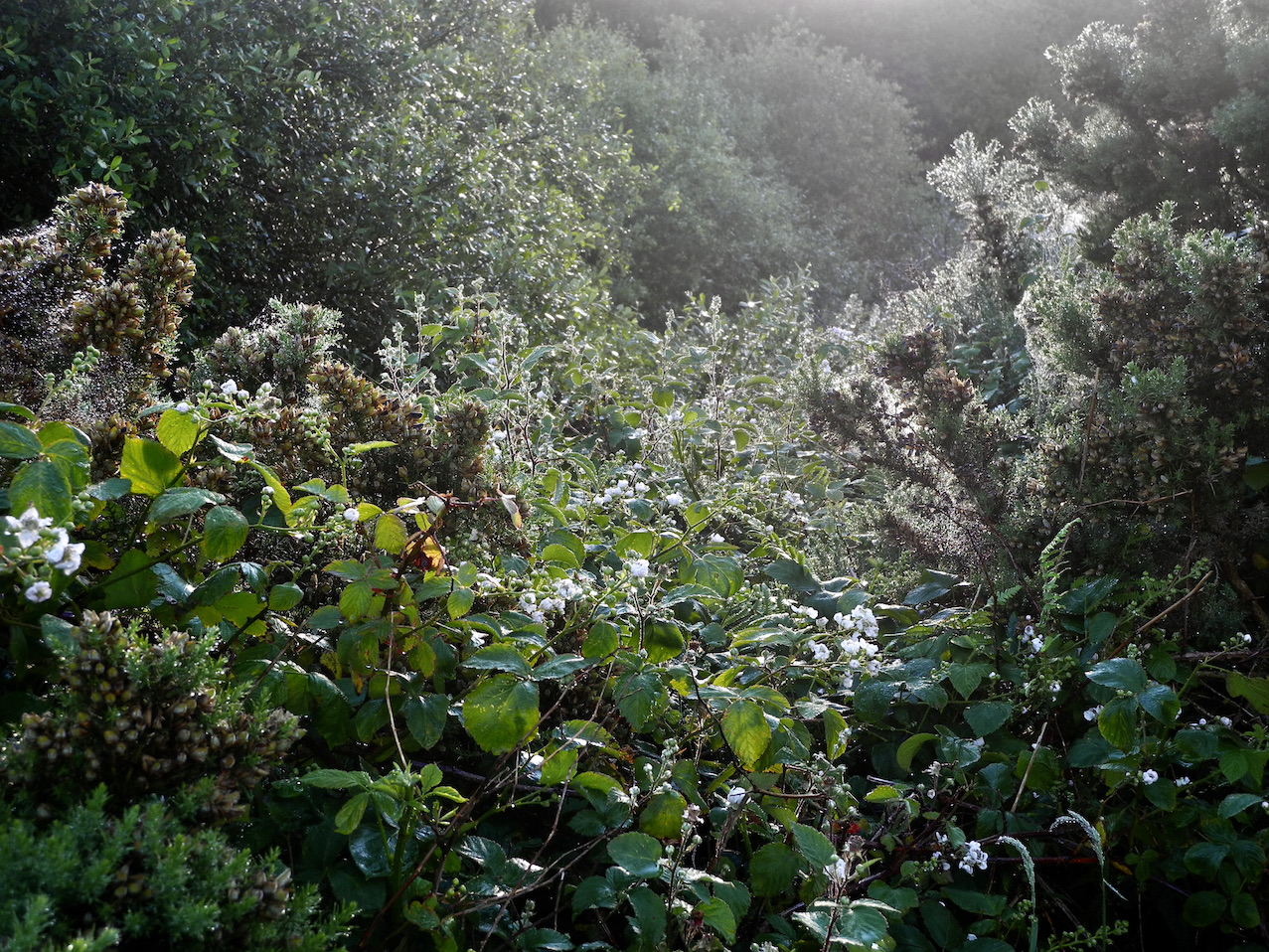
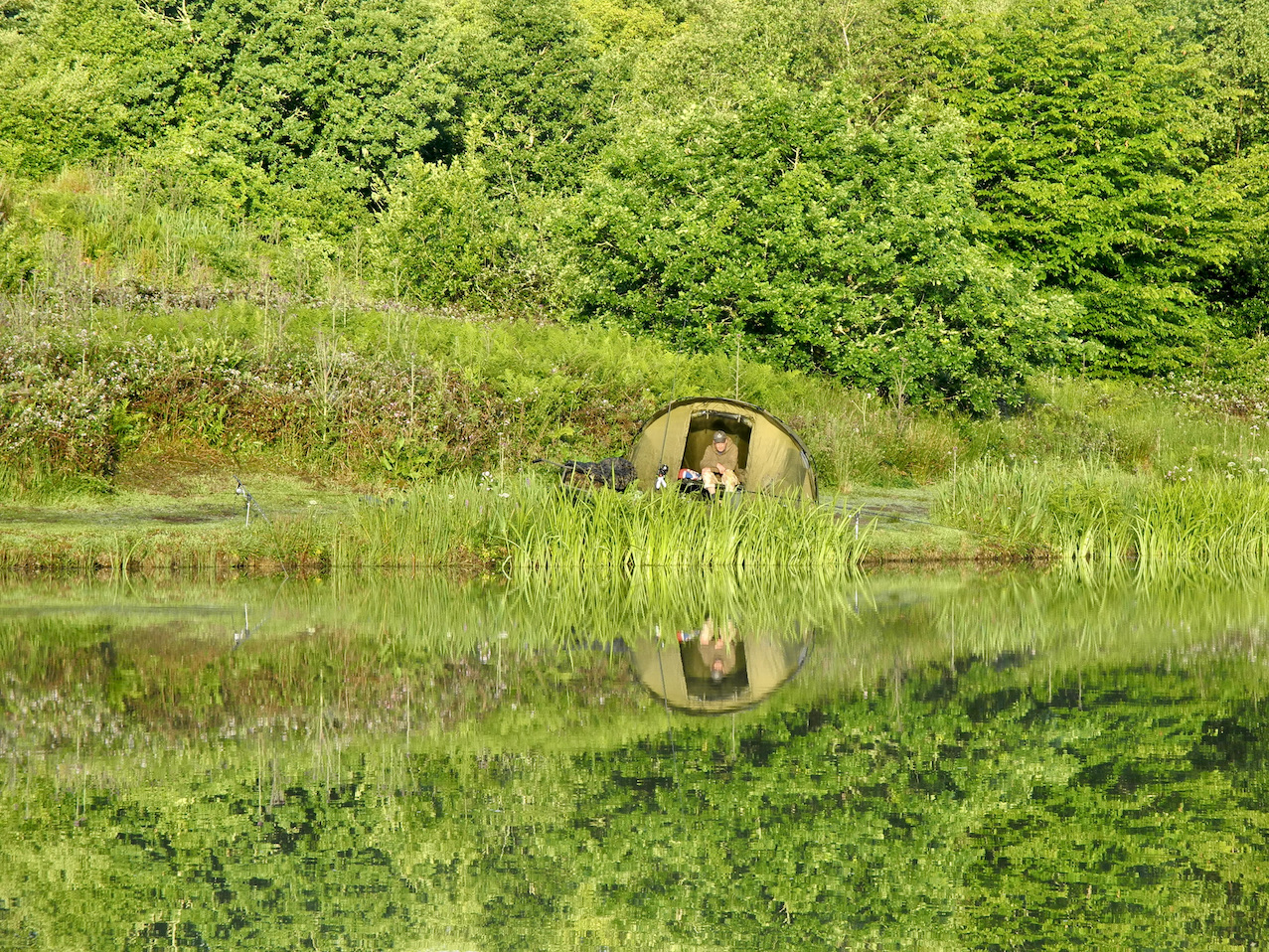
We all hoped for one last chance. Suddenly out of the blue came a call fish on! Ben was in action and after an exciting tussle brought a 24lb catfish to the waiting net.
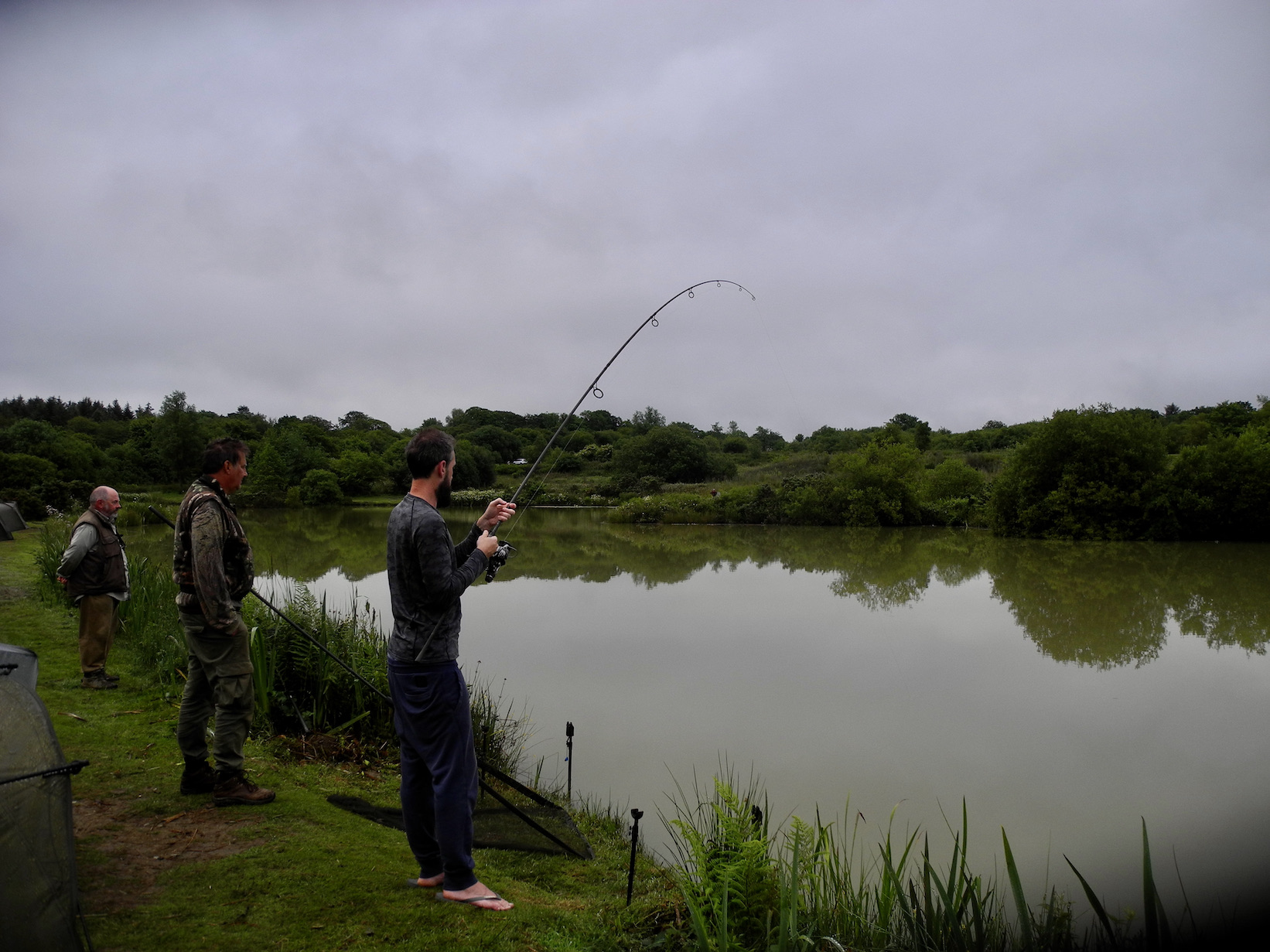
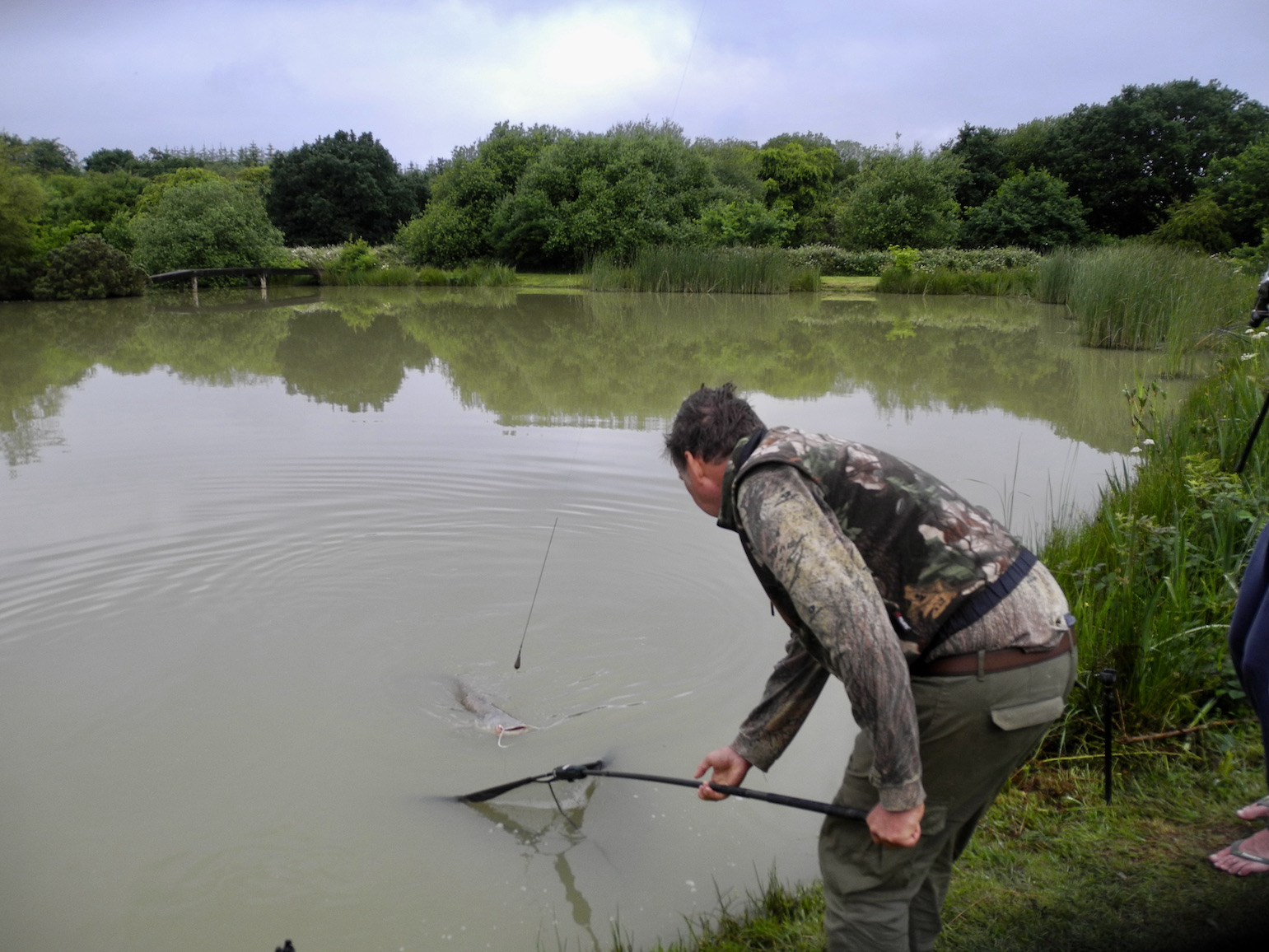
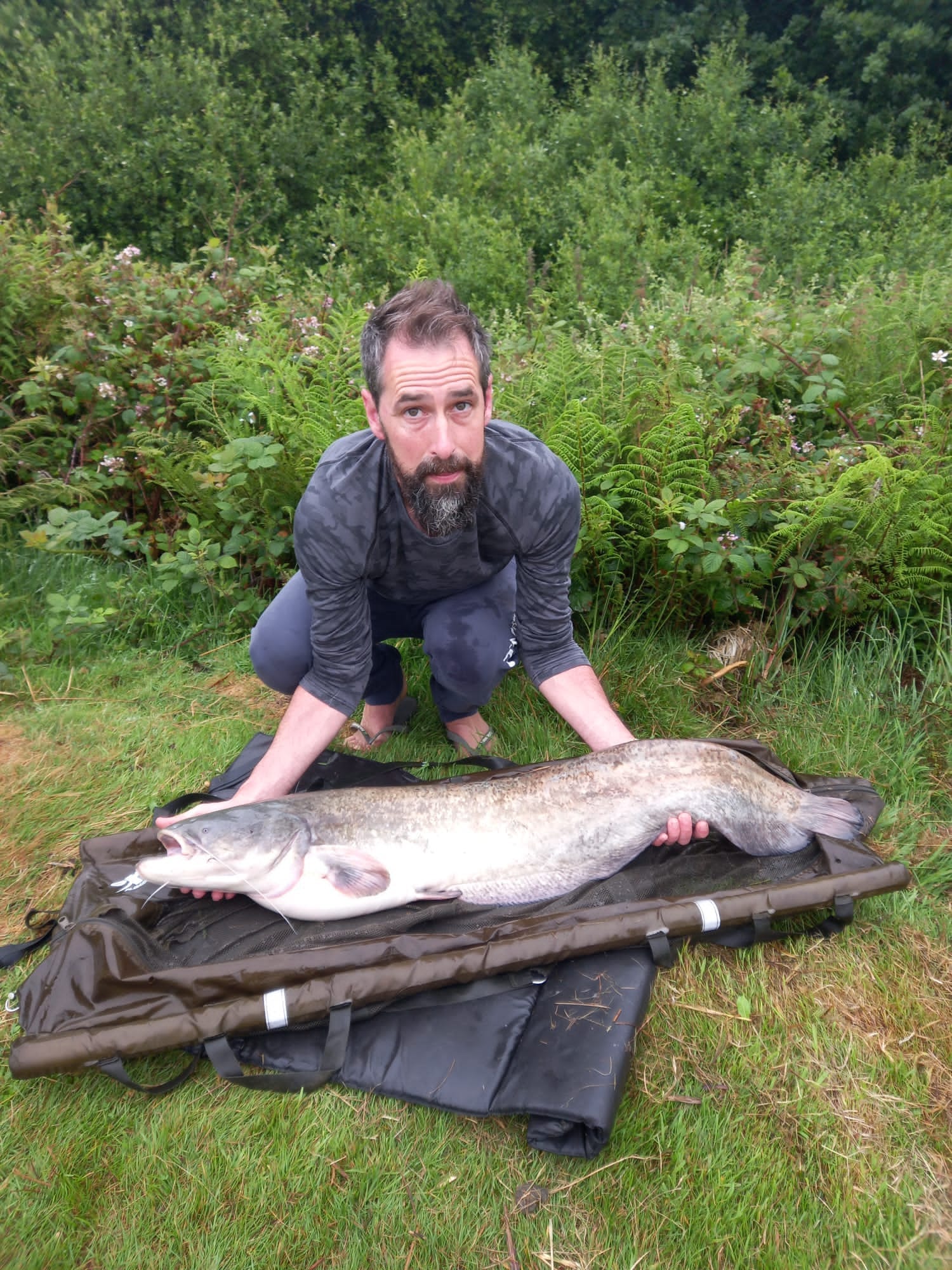
Tony avoided a blank by tempting a couple of kittens float fishing worms in the margin.
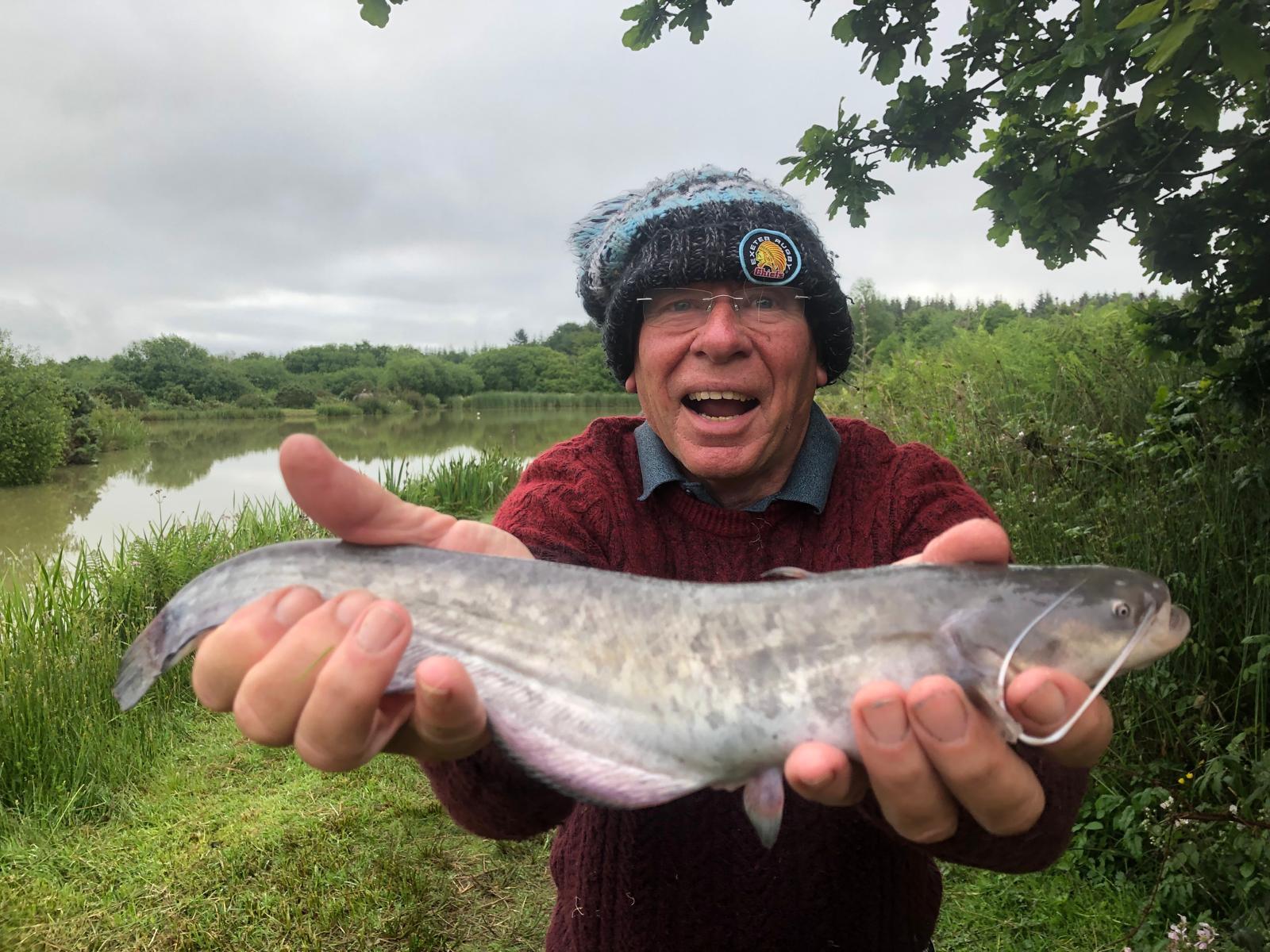
Then as we started to consider packing away John on the far side of the lake was in action. I watched the drama as John piled on the pressure, trying to prevent what was undoubtedly a big fish finding sanctuary in a tangle of branches and lily’s near the Island.
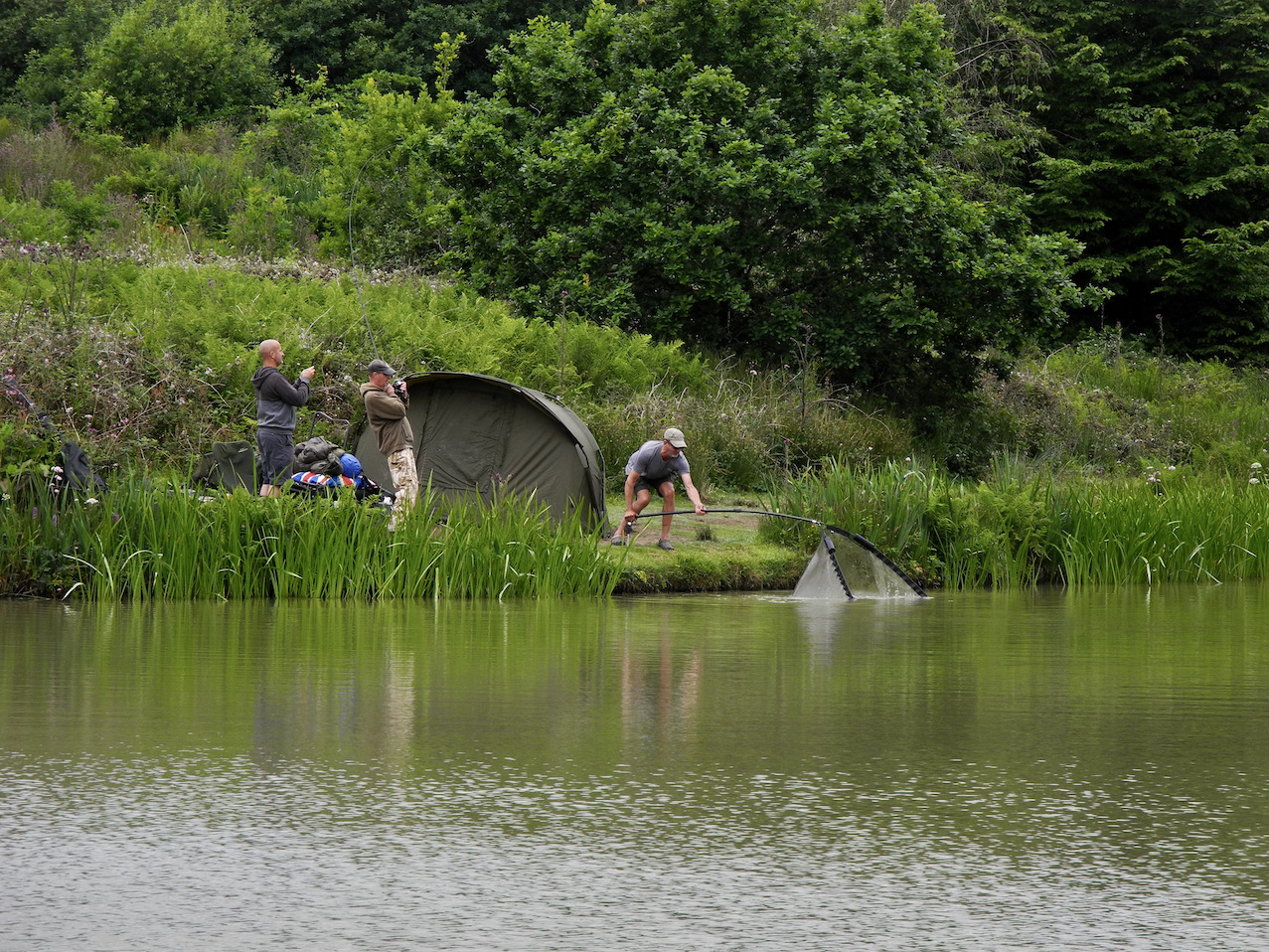
When the fish was safely netted I wound in my rods and walked around to witness the weighing and get a few images of the fish in daylight. At 39lb it was another fine specimen for John.
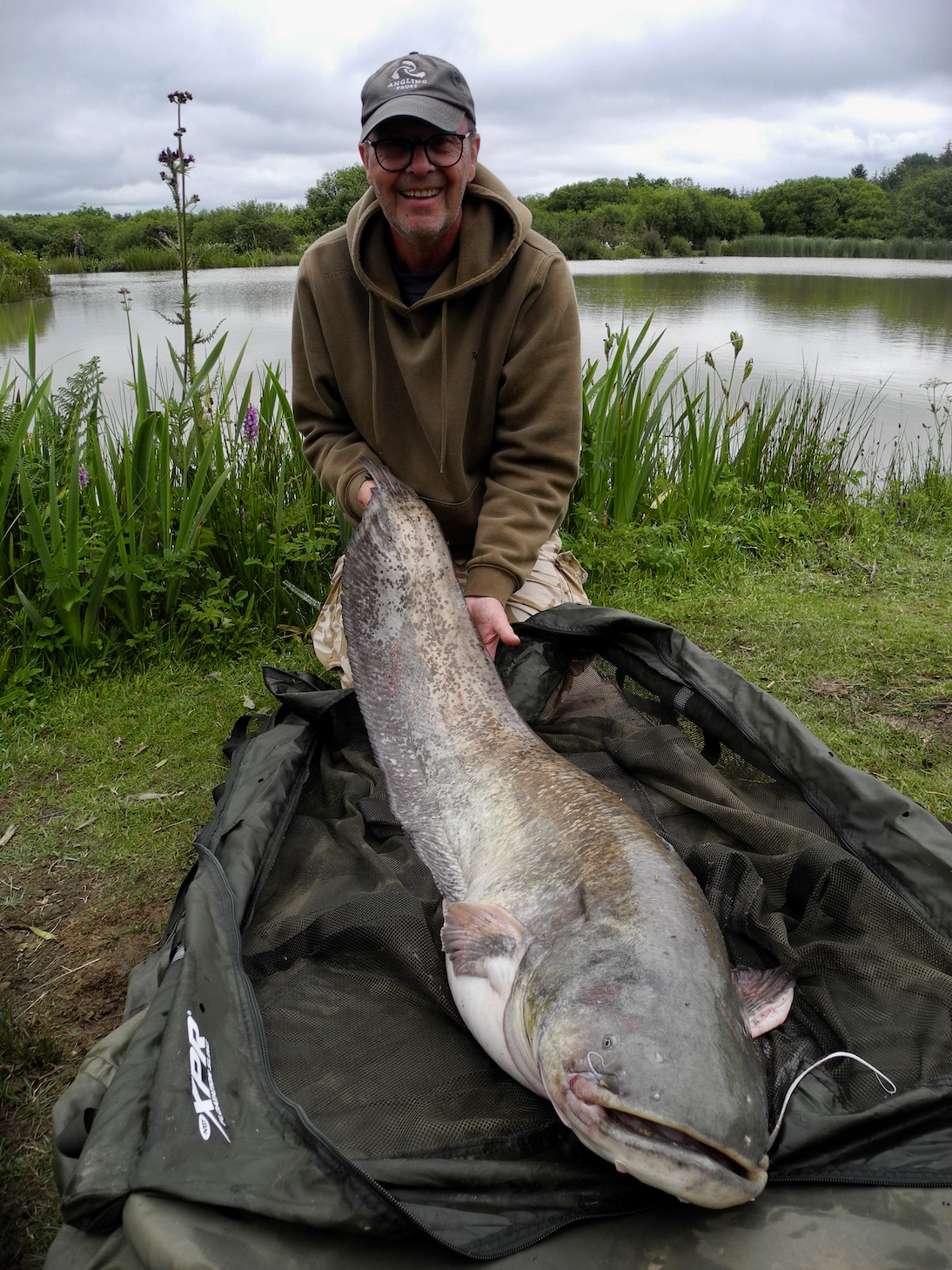
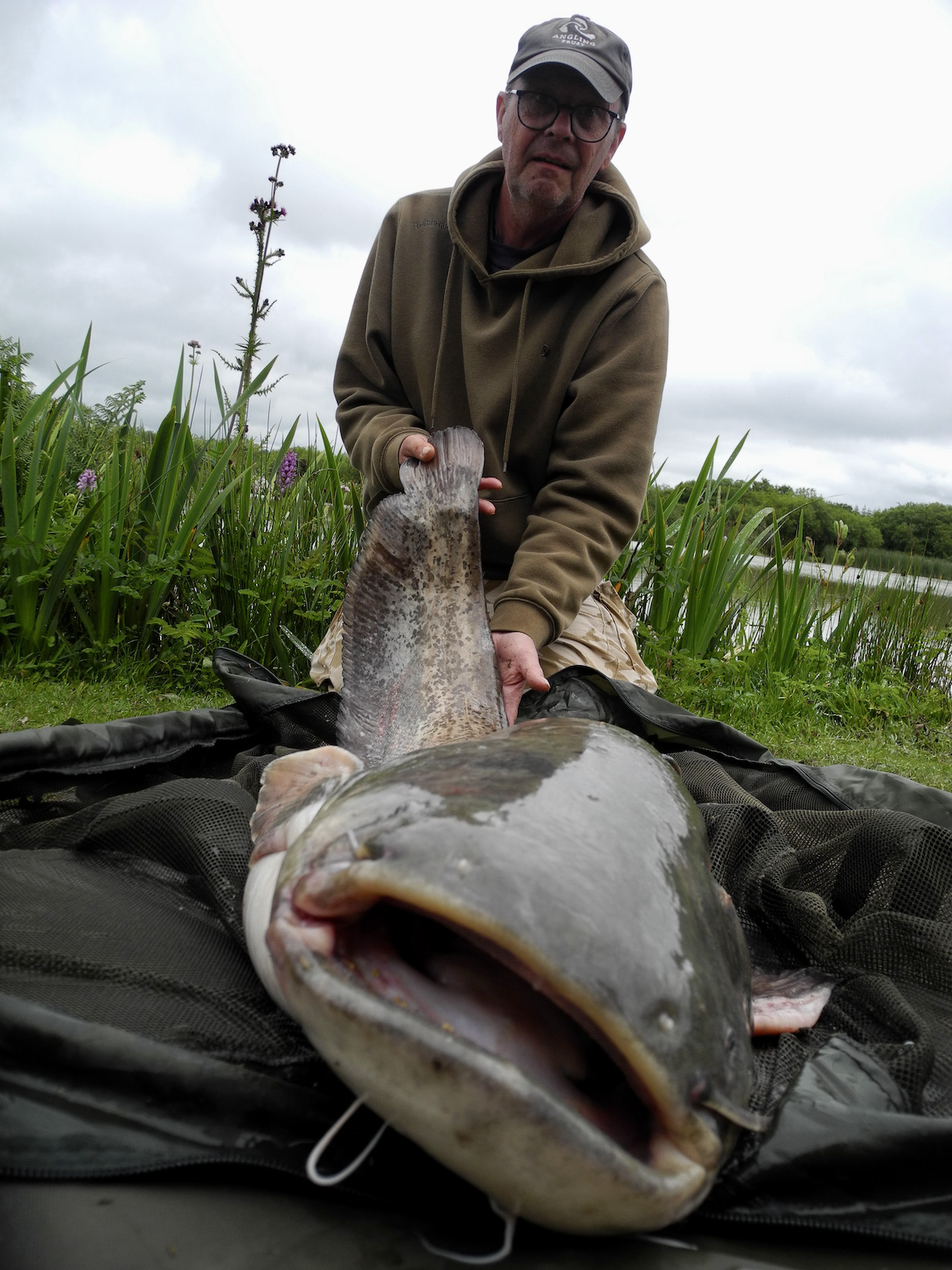
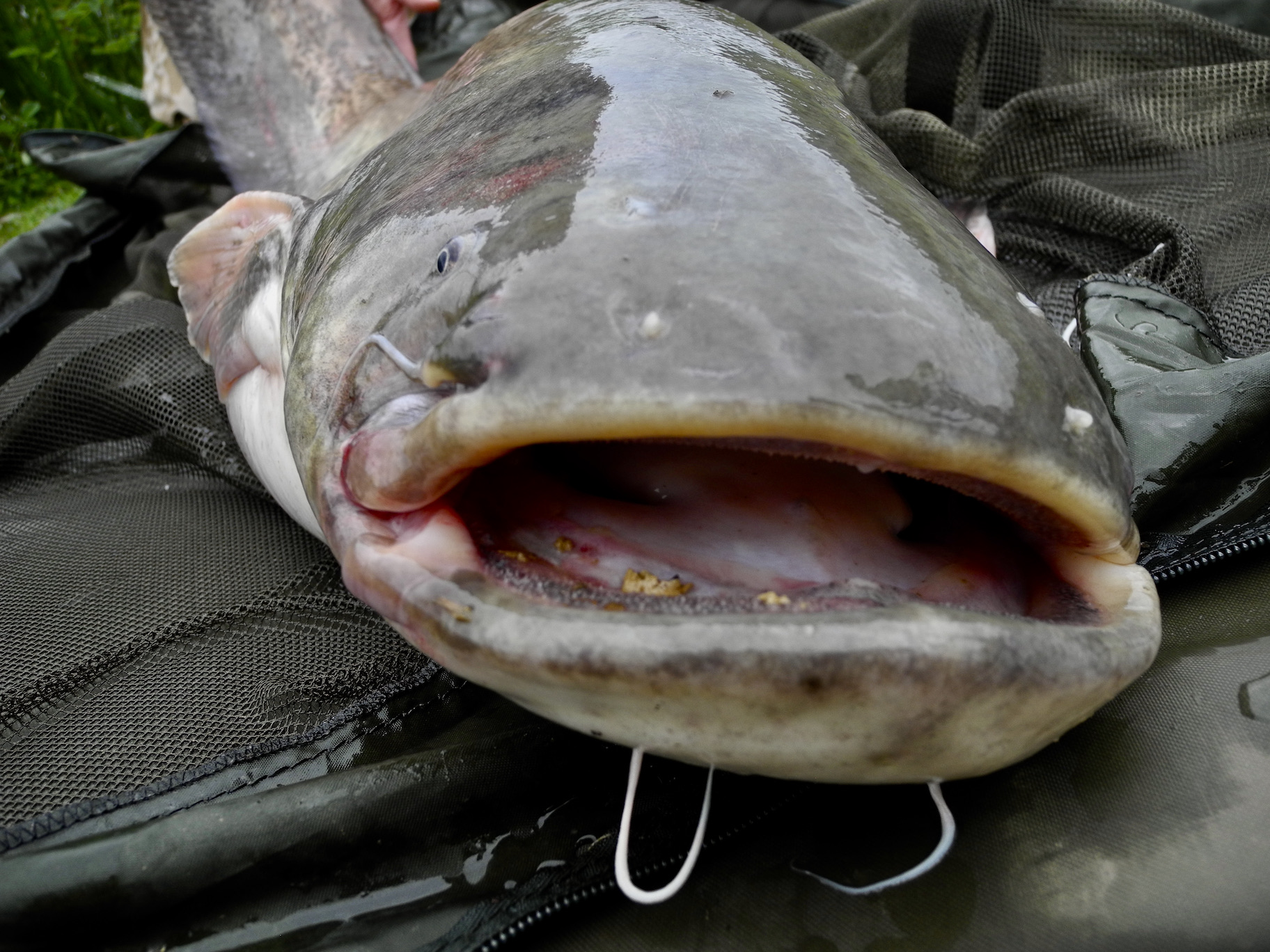
Whilst the fishing had been slower than hoped for the company had been great. Catfish weighing 49lb, 39lb, 39lb, 24lb and 21lb is after all a pretty good result.
We said our farewells after lugging the ridiculous heap of gear up to the cars vowing to do it all again next year.
Upon reflection it had been a very enjoyable excursion catching up with friends. Some big fish had been caught and discussion had left plenty to contemplate. Izaak Walton author of The Complete Angler first published in 1653 described angling as the ‘Contemplative Mans Recreation’. Somethings never change.

Many thanks to Richard Wilson for his wonderful articles filled with humour and comment to make you laugh and cry. Excellent observation of the human condition on this occasion.
Do you know any old goats?
See link below to Richards Fishrise page.

Even if you’ve never met Old Bodger in the flesh, you’ll know his ilk. In person, he’s socially awkward and his opinions are closely guarded. He’s also no spring chicken. The mullet went south years ago and the replacement comb-over is struggling.
But don’t be fooled: Old Bodger has secret superpowers.
At home, alone with his computer, he morphs into an Internet Warrior and owner of a snarling V8 hotrod (a relic, like Bodger, with far-distant echoes of the Beach Boys). Bathed in the blue light of his screen, he becomes a loud and proud throwback to a time when the world was a better place.
In his shaving mirror, Bodger sees a master of withering irony. A silken-tongued enforcer of online righteousness. This is odd because if there’s one thing Bodger can’t do, it’s the deft and gentle humour of irony. Subtlety is not his friend.
Instead, Bodger has two thrusting attributes: His rage against the modern world and his pride in his car, which is accumulating value at an astonishingly boastful rate. It’s a late ‘50s Barris-built Kandy-Kolored Streamline hotrod.
Of course it’s not all open road and wind in his hair. As we shall see, Bodger’s life is riddled with provocations, and the price of fuel is just first among many. And oh how Bodger rails against the cost of gas. It’s not fair, is it? If there’s one thing that really sets Bodger apart from most of us, it’s that he does outraged grievance with heavy-breathing ecstasy. His neighbours hear him pounding his keyboard late into the night.
There is, of course, a paradox in this. Despite the low-fi worldview, he’s spending a lot of time on the internet. Mostly on the arcane and genteel Vintage Split Cane Fly Rod Forum, where he stamps on heresy.
It is in his warrior DNA to wield his sword of truth and mightily slay imposters lurking on the VSCF-RF. You’d be shocked by what he finds there. Bodger stands proud against hordes of woke wussie, coal-hating, EV-owning, global warming, diet-Coke drinking, vaxing, barbless morons. It’s enough to make a warrior spill his coffee in foot-stamping rage (even his trouser stains are someone else’s fault).
What’s odd about this is that fishing etiquette matters a lot back in the real world. We all care about how we, and others, behave in person. Most of us can manage to listen politely to people we meet along the way while avoiding shit-talking with, or worse, at strangers. We try to be nice to each other, and mostly it works.
Somehow this all goes wrong online. Or, rather, it all goes wrong for Old Bodger and his scathing own-brand irony. Because when he calls someone a fracking nut-job, that’s ironic. Bodger also posts his irony in torrents. Which is OK because it’s all done for laughs: It’s full-frontal irony (I’ll leave it to you, dear reader, to deal with that image).
So if we po-faced dullards worry he’s mired in twaddle, he tells us we’re numb-knucks who wouldn’t know irony if it hit us in the po-face with a broken bottle: Lighten up! FFS. This is usually flagged by multiple rictus grin emojis 🤣🤣🤣. So, obvs, it’s all hilariously funny. Geddit 🤣 idiot?
Bodger has a small posse of camp followers, all lost in the same drear-life crisis.
Collectively they muster the charm of 13-year-old schoolboys, clumping on the back seat of a bus and lost in the hilarity of farting noises made with clammy hands wedged in each others’ armpits. Tee-hee. Somehow this humour always fails to impress the other passengers. Which, if you’re 13, is why you do it.
They’re a heavily ironic crowd, with names like Curmudgeon, Farter, Whittler and, inexplicably, Blue VerruKa. You don’t know it, but they own you and you’re dancing to their tune. And just in case you’re wondering, ‘Owning’ people means: ‘I dunno what you’re talking about, but I bet I can really annoy you if I vomit on your carpet’. Ah, the delicious irony of it all.
The posse is so lost in their jokes-on-you irony that we must assume that Bodger has never read The First Rule of Goats. He should. It is succinct, if a little crude.
For readers unfamiliar with the Rule and who don’t like to see the word ‘fuck’ in print, I have substituted ‘grope’.
So, the (sanitised) First Rule of Goats says: “If you grope a goat, even if you say you’re doing it ironically, you’re still a goat-groper. You don’t get off scot-free just because you say ‘I was only being ironic’.”
The corollary Rule to this is:
“If your rhetoric is all about goat-groping, even if you’re doing it ironically, you’re liable to attract a following of goat-gropers”
And finally: A mint Kandy-Kolored Streamline built by the legendary George Barris is a special beast. An original would, you’d think, make Bodger’s home a magnet for well-heeled ‘50s car collectors. After all, the Barris Batmobile last sold for $4.2m.
Weirdly, nobody calls.
And that is ironic*.
*Poignantly contrary to what was expected or intended.
—- —- —- —-
Post Script: For more on the very real George Barris and the equally real Kandy-Kolored Streamline hot-rods, Tom Wolfe’s essay of almost the same name is a great read. Thanks also to Ken White for the First Rule of Goats.
Old Bodger, Curmudgeon, Farter, Whittler and Blue VerruKa are, of course, fictional characters.
 Mainline Baits Pairs competition – Friday 19 July – Sunday 21st July 2024 The Mainline Baits Carp Pairs competitions are held at our fantastic 81-acre fishery, Upper Tamar Lake. This is a fun, friendly competition, open to all, with some fantastic prizes up for grabs! The competition is limited to 34 pairs so book your place now to avoid disappointment 👇https://www.swlakestrust.org.uk/mainline-baits-carp-open-pairs-competitions or 01566 771930 1st Prize – £2000 2nd Prize – £1000 3rd Prize – £500 There are also prizes for biggest fish and section winners up for grabs. Each person who enters will get a goody bag with some fantastic Mainline products inside. All tackle and equipment is transported to and from your swim. There is also a full menu for the weekend with food delivered directly to your swim!
Mainline Baits Pairs competition – Friday 19 July – Sunday 21st July 2024 The Mainline Baits Carp Pairs competitions are held at our fantastic 81-acre fishery, Upper Tamar Lake. This is a fun, friendly competition, open to all, with some fantastic prizes up for grabs! The competition is limited to 34 pairs so book your place now to avoid disappointment 👇https://www.swlakestrust.org.uk/mainline-baits-carp-open-pairs-competitions or 01566 771930 1st Prize – £2000 2nd Prize – £1000 3rd Prize – £500 There are also prizes for biggest fish and section winners up for grabs. Each person who enters will get a goody bag with some fantastic Mainline products inside. All tackle and equipment is transported to and from your swim. There is also a full menu for the weekend with food delivered directly to your swim!
June 2024
The weather continues to warm up, as have the water temperatures (in spite of unseasonably cold nights and some cooler breezes), with steady insect activity, and fish feeding well either on or just below the surface; some wet days and heavy downpours of rain have meant that most of the reservoirs are still all at top level.
Fishing:

Kennick – Anglers averaged 2.6 fish per rod over the month, with fish continuing to be well spread out around the lake. Bank anglers enjoyed slightly more success than the boats, with The Narrows, The Lawns, Boat Bank, Laployd, Smithacott and Poplar Bay banks fishing particularly well, and boats catching well in the deeper central water. Natural airborne beetles, caddis, crane-flies and hatching Damsels have meant that many fish have been feeding on or near the surface, with anglers catching well using Foam Beetles, Black Hoppers, Daddies, Sedges, Hawthorns, Claret Snafflers and Emergers on the surface, using floating lines with long leaders and a slow retrieve. Subsurface feeders have been caught on Damsel Nymphs, Buzzers, Montanas, Bloodworms and Diawl Bachs, while lure anglers caught using Cats Whiskers and Boobies. Peter Gilpin (from Newton Abbot) caught ten rainbows to 3lb 9oz in one session, mainly on Black and Green Boobies; Ben Garnett (from Kenn) caught a 2lb 9oz rainbow while fishing in the early evening, casting to a feeding fish in Boat Bay, using a Diawl Bach; Alex Jackson caught a bag of four fish to 2lb 8oz, casting to topping fish along the West Bank. The annual Peninsula Classic bank competition, sponsored this year by Turralls, was won by Alex Venn, catching a bag of seven fish, weighing in at 13lb 12oz; Alex Jackson (from Australia) took second place with five fish, weighing 9lb 12oz; John Hern (from Exeter) caught the biggest fish of the day – a rainbow of 2lb 8oz.
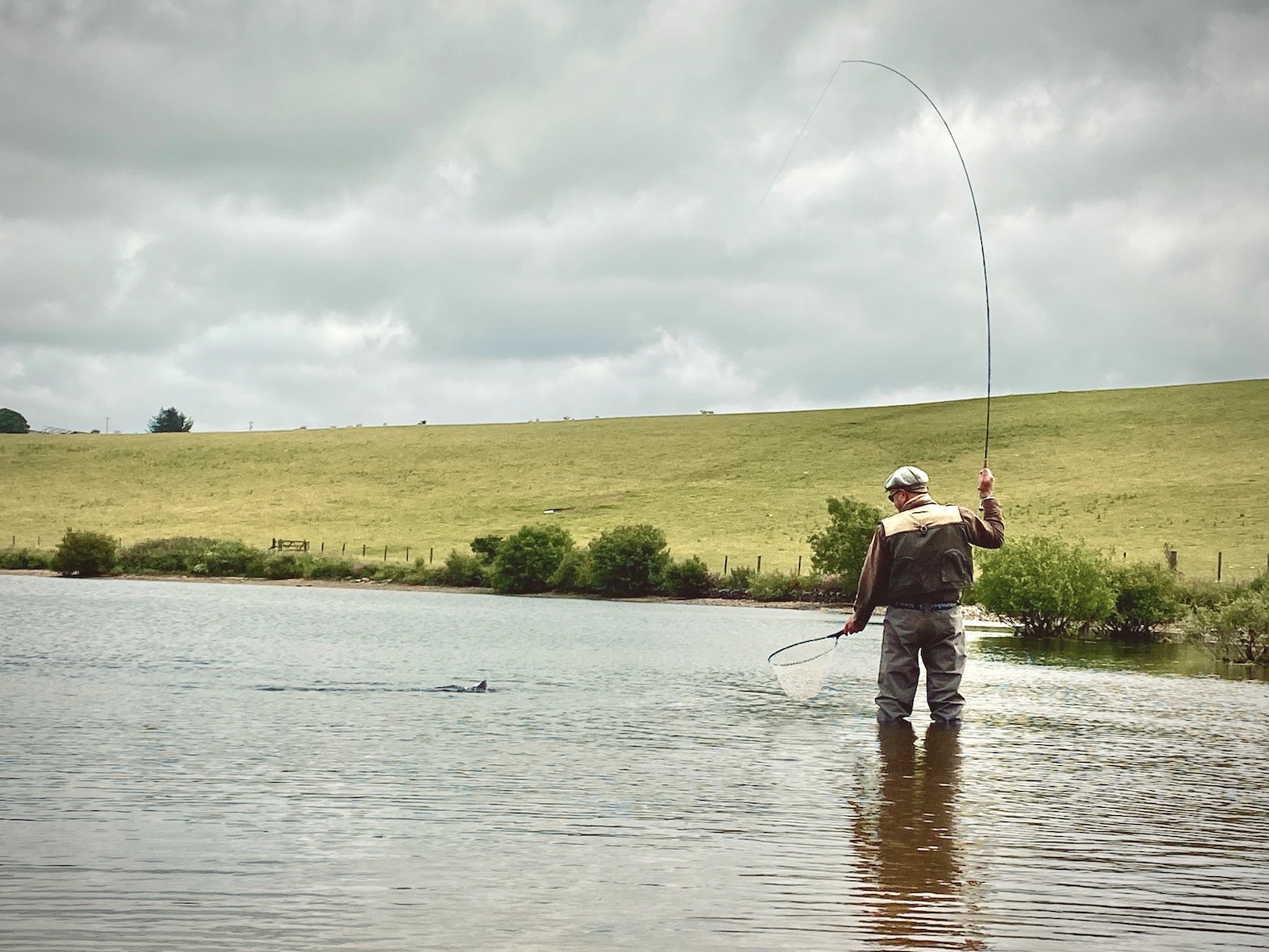
Siblyback – This fishery continued to provide some excellent fishing, with anglers averaging 4.7 fish per rod, with the North Bank, Two Meadows, Stocky Bay and Crylla Bay producing the most consistent sport (although fish have been caught all over the lake, and seem to be well spread out). Plenty of air-born beetles and hatching buzzers meant that the fish were eager to look up to the surface to feed, with Beetles, Hawthorns, Sedges, Coch-y-bondhus and Hoppers all catching well. Deeper feeding fish were caught on a selection of nymph patterns (Damsel Nymphs, Gold Head Hares Ears, Montanas and Diawl Bachs) and lures (Boobies, Tadpoles, Orange Blobs, Orange Baby Dolls and Vivas). Ron Wilday (from Liskeard) had some excellent sessions, the best producing a bag of twelve rainbows (to 2lb) and one brown while fishing one morning in Stocky Bay, with fish feeding close to the surface.
Burrator – Anglers averaged 2.34 fish per rod over the month, with Longstone, Bennetts, Sheepstor and Pig Trough producing the best sport. Sedge hatches produced the best surface feeding activity, when fish were caught using Black Gnats, Daddy Longlegs, Hoppers (black and red) and Beetle imitations. Fish could, however, be caught at all depths, when Montanas, Crunchers, Damsel Nymphs, Orange Blobs and Tadpoles all succeeded in catching fish. Roger Prout (from Pensilva) caught a bag of ten rainbows in a session of very mixed weather conditions, using a floating line with a midge-tip, either with fast strips using a Cormorant, or a static line with Buzzers and Beetles. Allan Lawson (from Plymouth) caught a bag of five rainbows to 1lb 12oz and a brown using both a floater and slow-sink line; Andy Lawson (from Plymouth) caught a bag of six rainbow to 1lb 8oz, either stripping white lures on an intermediate line, or using dry Black Caddis and Beetle patterns fished very slowly.
Stithians – The lake continued to produce some excellent sport, with anglers averaging 3.6 fish per rod, and fish still well spread out around the lake (Pipe Bay, Yellowort, Goonlaze, Pipe Bay and Sailing Club Bank all received regular mentions on catch returns). Buzzer hatches and air-born beetles meant that there was plenty of surface action, with dry Daddies, Hawthorns, Hoppers, Black Gnats, Beetle patterns and buzzer emergers all catching well. Damsel Nymphs, Hares Ears, Diawl Bachs and Black and Peacock spiders all caught deeper feeders, mainly fished on a floating line.
Fernworthy – Most of the fish caught this month have been on or near the surface, either on dry patterns (Beetles, Hoppers, Bobs Bits, Sedgehogs and Black Gnats), or nymphs (Diawl Bach, Pheasant Tail and Spiders) and larger patterns (Soldier Palmer, Invicta and Bibio) fished just under the surface and cast to feeding fish. The most productive areas included Brownhills, Thornworthy, Permit Hut bank and near the dam.

Colliford – The fishing continued to improve this month, with rods averaging five fish per angler, with the preferred locations including Fishery Hut bank, Lords Waste and the banks by the dam. The browns were looking to the surface to feed on beetles blown onto the water, and floating lines with long leaders produced the best results. Coch-y-bondus and foam beetle patterns, along with Sedges and Hoppers, caught well on the surface, otherwise pulled lure patterns (Soldier Palmer, Zonker, Black Mini muddler, Bloodworm and Bushy Blob) fished just under the surface attracted fish. Included in the nice bags caught in the month were Chris Tillyard (from Fraddon), catching eleven browns to 1lb 8oz in an evening session, using Black and Peacock spiders and Hoppers; Dean Boucher (from Gunnislake) caught eleven browns, all on pulled wets in one session, and twelve fish to 15” on Beetles, Hoppers and slow-retrieve team of nymphs in another; Paul Mockford (from St Wenn) caught eight browns to 1lb 8oz on beetle patterns.
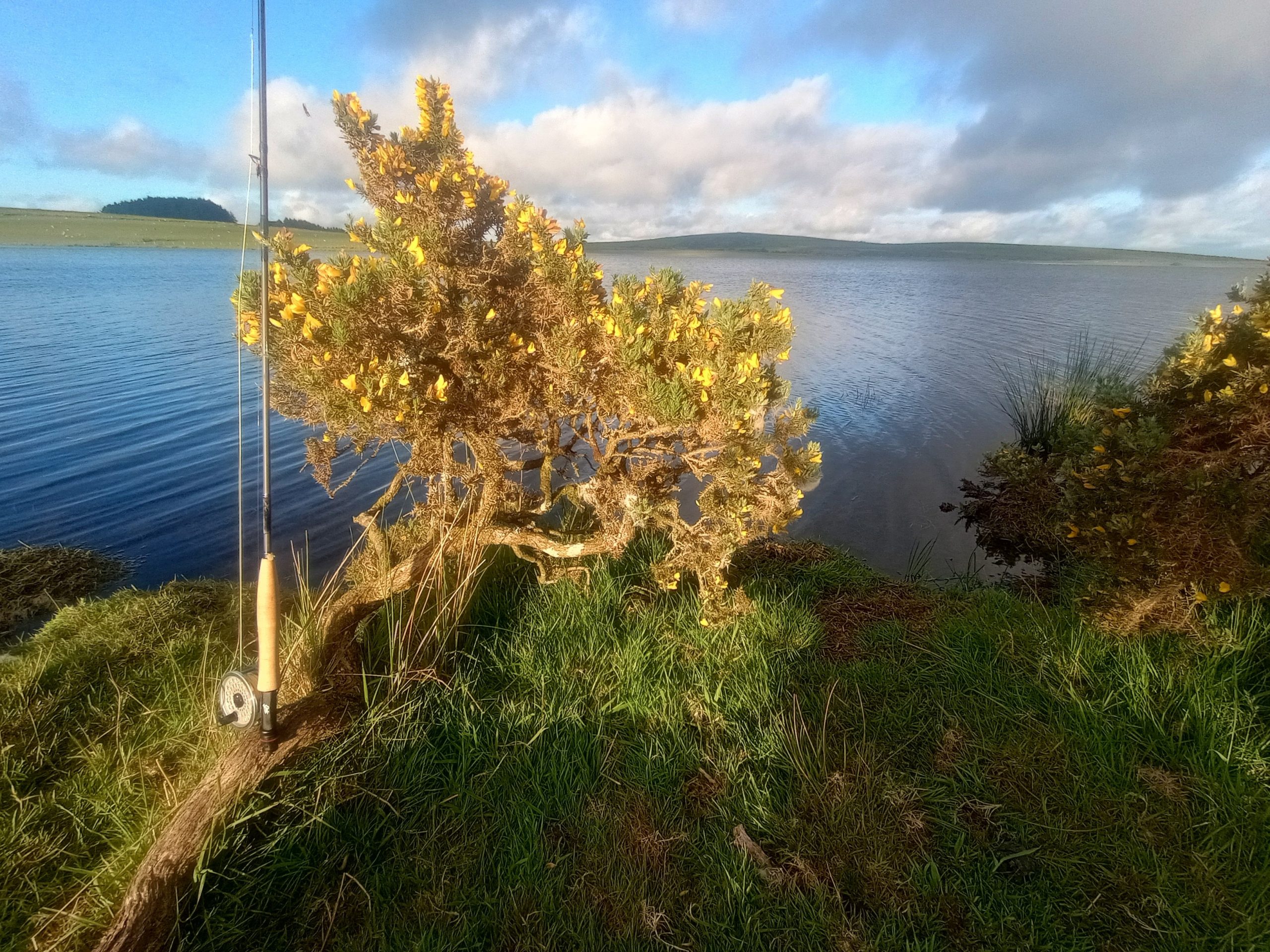
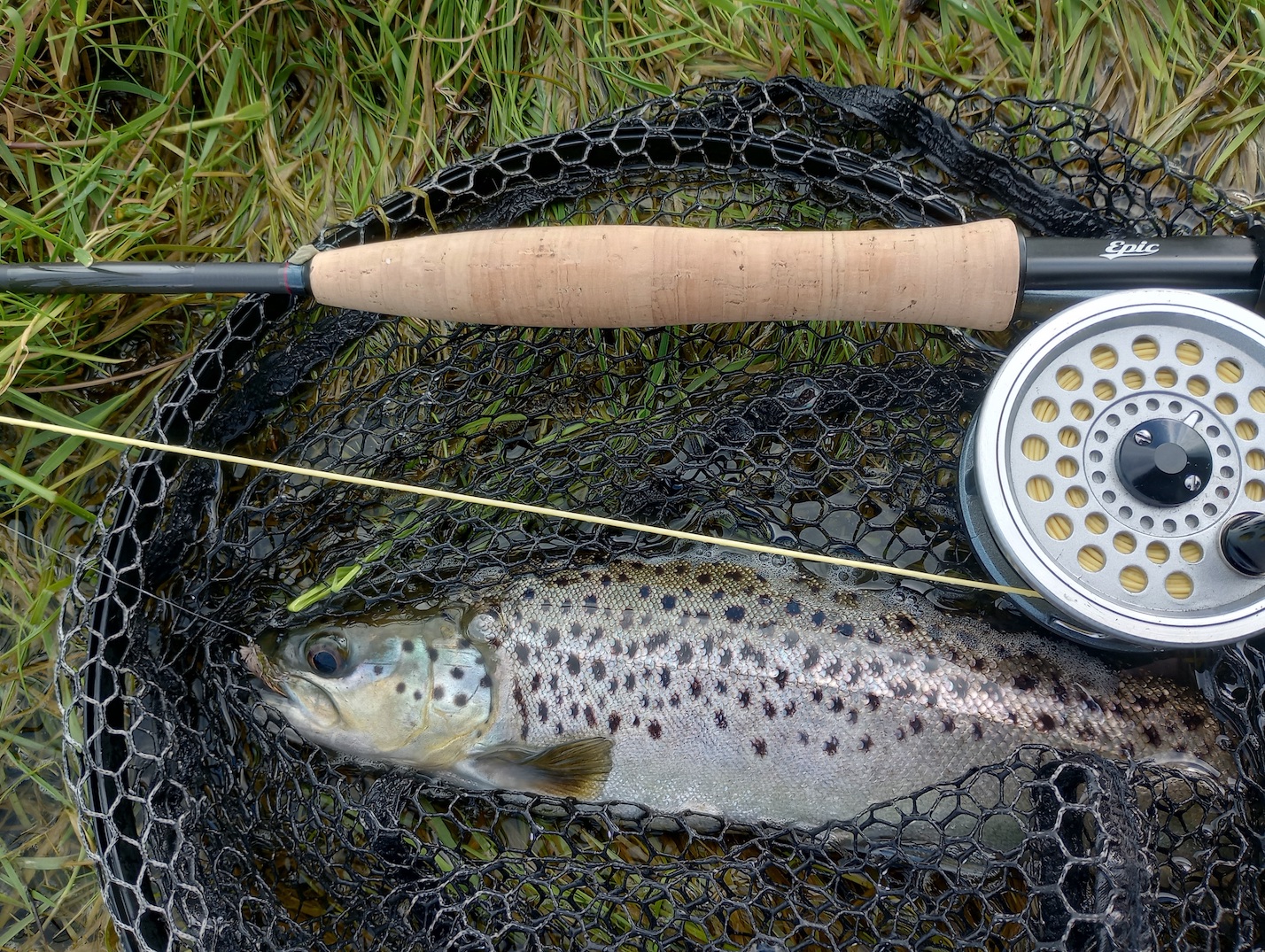
Roadford – Floating lines with long leaders proved to be the best combination, with fish taking a variety of patterns, including Humungous, Sedgehog, Buzzers, Damsel nymphs, as well as the more traditional Coachman and Whickhams Fancy. Fish were well spread out, with Wortha, Shop Inlet and Grinnacombe all proving popular. Rodeny Wevill (from Lifton) caught four browns to 2lb, using a floating line with a long leader and fishing slow and deep, with the best sport in the last hour before sunset.
Please see the Trust’s website (www.swlakestrust.org.uk/trout-fishing) for more information on buying tickets, boat availability and booking, and forthcoming events. The Trust, in conjunction with Fluff Chuckers, will be running a Brown Trout Masters competition this season, to be held over three dates at Colliford, Fernworthy and Roadford – please see the website for more information.
Chris Hall (June 2024)
ENDS
 LATEST REPORT FROM BULLDOG TROUT LAKE
LATEST REPORT FROM BULLDOG TROUT LAKE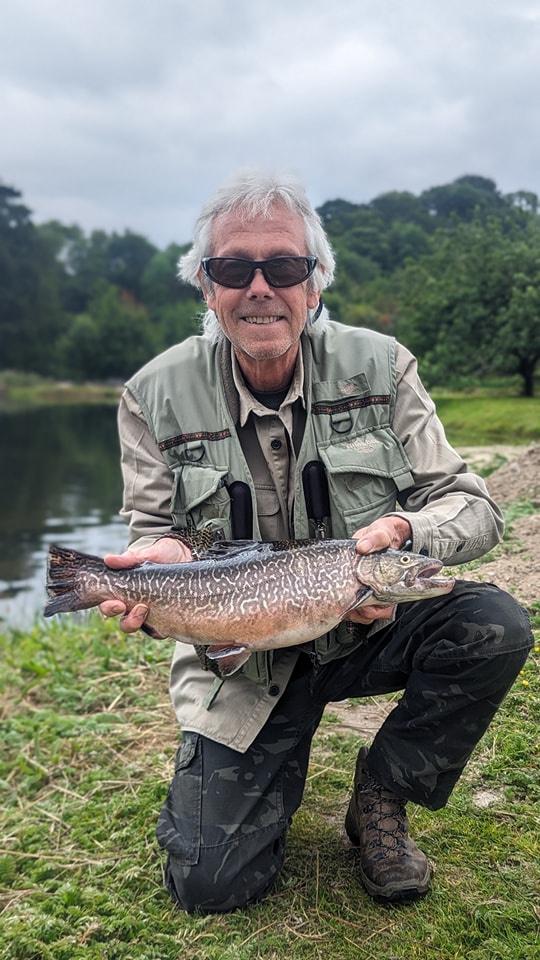
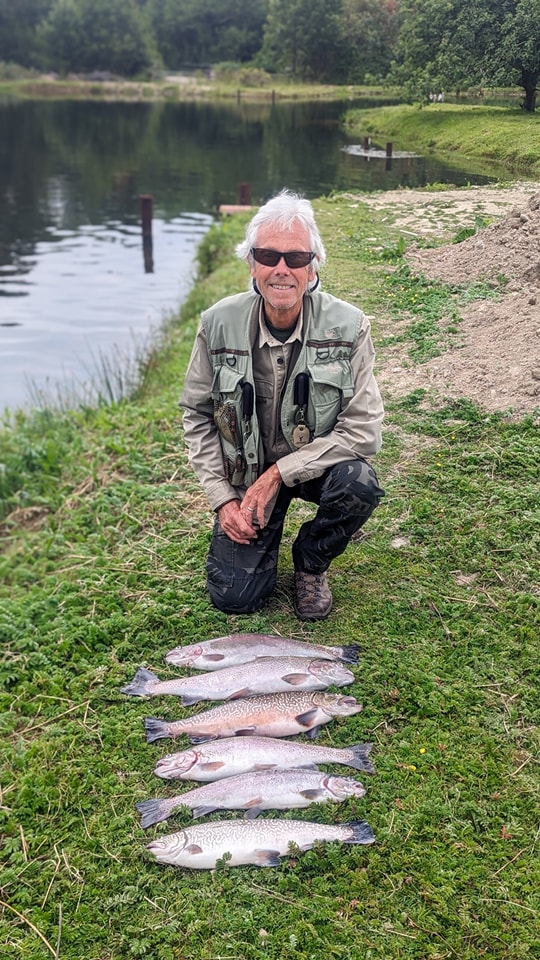 As luck would have it he landed not one but two Tigers on his 6 fish ticket!
As luck would have it he landed not one but two Tigers on his 6 fish ticket!
Heady June Summer Days |
|
Warm sun, the heady scent of honeysuckle in the hedgerows, the excitement of the first sea trout coming through and it seems those bitter northeast winds of last week have been relegated to nothing but a distant fading memory. Thank goodness summer is finally here!
There has been much excitement after a very successful, slightly windy but warm and balmy day up on the North Devon shoreline, with several well sized sea bass caught. Slightly closer to home on the Lower Lyd, it was the sea trout coming through that had the Fishing Shop buzzing with excitement. A total of 5 were caught last week with the largest coming in at 3 lbs and a couple in at 2.5 lbs. More generally, on the rivers there are still plenty of hatches to be found and when they come it can be fantastic with some 20 wild brown trout caught in just a couple of hours.
The Arundell gardens are now well and truly in their full June glory. Rambling pink roses, the delicate green of the euphorbia, the exotic aroma of the yellow yarrow and the occasional bright flash of the lupins. An English country garden at its best and its wonderful to see the Afternoon Teas on the terrace are in full swing!
For those with young children, don’t forget that on the last two Saturdays in July (20th & 27th) and most Saturdays in August (3rd, 10th, 24th & 31st) we will be offering our 1 hr introduction to fly fishing lessons down at the lake. Booking essential. |